Abstract
A study was conducted through quantitative calculations on the correlation between the micron-scale pores and the strength of nano-SiO2 (NS) sol reinforced cement mortar. The strength, pore structure, and microstructure of NS sol modified mortar were investigated, and the mortars were made equivalent to a two-phase material comprised of pores and mortar matrix; the model was applied to conduct a quantitative analysis of the correlation between pores and the strength. According to the research results, the modification made to the mortar using the NS sol led to significantly increased early strength and the level of porosity was also increased. Furthermore, the addition of NS caused a change to the C–S–H gel morphology of cement hydration products. As revealed by the results of quantitative analysis, the addition of 1.5 and 3% NS improved the mortar matrix strength by 29.3 and 56.6%, respectively. Moreover, the ratio between the mortar strength (f c) and matrix strength index (K) exhibited a nonlinear correlation with the porosity negatively. It was thus inferred that the increase in mortar porosity inhibited the improvement of mortar strength under the influence of NS sol.
1 Introduction
Admixtures and fibers can be added to cementitious materials to achieve high performances and long lifetimes [1,2,3]. The use of nanomaterials has been proven to be one of the most effective methods for reinforcing cementitious materials [4,5,6]. Incorporating a small amount of nanoparticles in concrete can modify the nano-structure of cementitious materials, and thus procure high durability [7].
Nano-SiO2 (NS) is the most extensively used nanomaterial for cementitious materials [8,9]. Many researchers have focused on the effects of NS modification on the various characteristics of cementitious materials. Xu et al. [10] found that NS enhanced the elastic modulus ratio of the interfacial transition zone to cement paste increases from approximately 50 to 80%. And the strength of the cement paste was enhanced by 20–28% at an age of 28 days [11], and the strength of mortar with 12% NS particles was enhanced by 77% at an age of 7 days [12]. In relation to durability, NS can enhance the sulfate resistance of concrete [13]. In the study of Zhang and Li [14], the chloride permeability coefficient of NS-modified concrete was significantly reduced. In a test of the scanning electron microscope (SEM), the microstructure compactness of cement composites is improved by NS [15,16]. In addition, the frost resistance of the NS-modified concrete was improved [17,18], and the concrete water absorption rate could be decreased by the NS modification [19]. Zhang et al. [20] found that NS could greatly improve the impact resistance of steel fiber concrete. In the study of Li et al. [21], the service lives of coated concrete against chloride attack can be lengthened by 7.1 times 0.5% NS are added into the coating.
Although NS can improve the overall performance of cementitious materials, the excellent performance provided by NS modification is not fully utilized when the NS particles form aggregates in the cement matrix [22,23]. New industrial sols have been stable for long periods, which has significantly promoted the extensive application of nanomaterials [24,25]. Attempts have been made to use an NS sol to solve the issue of silica nanoparticle dispersion in cement [26,27]. The mortar strength increases with the increase in the amount of NS sol. However, when it exceeds a certain amount, the growth effect is not obvious and there is a downward trend [28].
The pore structure has important effects on the properties of cement mortar and concrete and is especially closely related to the strength and transmission properties [29,30,31]. In the study of Han et al. [32], it was concluded that the correlation between the pore microstructural characteristics and mechanical properties was very strong. Porosity reduction and refinement of the pores in a cement paste increase the strength [33]. It is feasible to predict the performance of a cementitious material based on its pore structure characteristics [34].
Most of the studies intended to analyze the pore structure of cement-based materials by visual inspection, SEM, mercury intrusion porosimetry [33], 3D X-ray computed tomography (CT) [35], nuclear magnetic resonance (NMR) [36] and nitrogen adsorption–desorption measurement [37]. However, these methods have some shortcomings, for example, NMR and CT testing are complex and expensive [38], and each method has its own applicability. The measurement of pore structure analyzer (PSA) is a panoramic pore structure analysis method based on the optical microscope, and it is a widely recognized method for pore structure analysis. The collection of pores in the whole concrete cross-section by PSA is more suitable for the establishment of a strength quantitative model [42].
The improvement of pore structure in the microstructure by NS is one of the mechanisms for enhancing cement materials. In the result of Huang et al. [13], the incorporation of NS refined the pores and reduced the pore connectivity, which led to the improved sulfate resistance of cement mortars under partial immersion conditions. Feng et al. [23] found that NS particles successfully densify the pore structure, particularly leading to the reduction of large capillary pores. In the literature [39], the pore volume with a pore diameter greater than 10 μm accounts for the largest proportion, and the macro-pore was considered to be caused by the presence of entrapped air in the fresh paste during processing, which has not caused concern.
A review of all of the research conducted so far indicates that the effect of NS on the increase of micron-scale pores has not received attention. However, the increase in meso-porosity obviously has a great influence on the mechanical properties and durability of cement-based materials [40,41], which is an obstacle to the application of NS-modified cement-based materials.
To discuss the issues mentioned above, this article analyzes and models the effect of increased micropores encountered in the application of NS-modified cement-based materials, while building a bridge between the pores and strength. And this study aims to provide some information in terms of the research challenges encountered thus far. In particular, the correlation between mortar strength and micro-pore structure under the influence of NS sol was discussed by calculating the mortar matrix strength index.
2 Experimental
2.1 Raw materials
The NS sol, reference cement, natural river sand, and polycarboxylate superplasticizer (PS) were used as the raw materials. The NS sol was prepared using a simple silicon colloidal sol method, and the NS sol was directly mixed into the cement mortar as an admixture, the agglomeration of NS particles in cement was avoided because NS sol has favorable dispersion stability [42]. The SEM image of the NS particles in the NS sol is shown in Figure 1. The properties of the NS sol are shown in Table 1. Reference cement P.I 42.5 was used, and its main properties are listed in Table 2. Natural river sand was used as fine aggregate for the mortar. Its apparent density was 2,744 kg/m3, and its fineness modulus was 2.94. PS was provided by Sobute New Materials Co., Ltd. (Jiangsu, China), white powder.
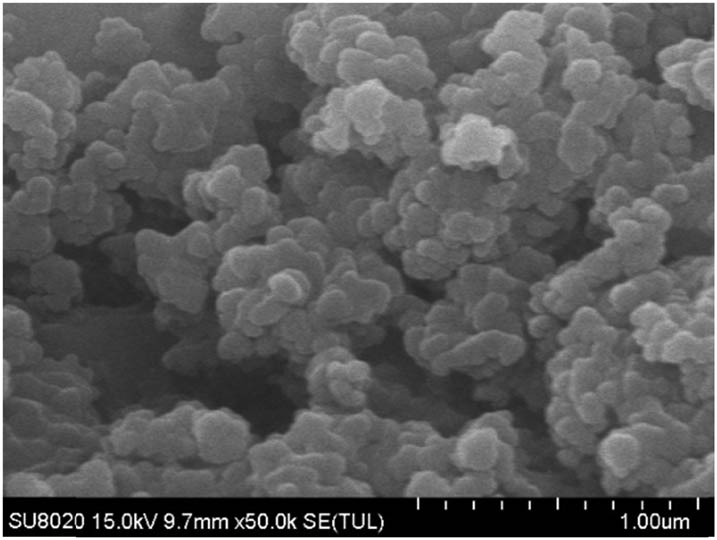
SEM image of NS particles precipitated by NS sol.
Properties of NS sol
| Appearance | Particle size | Content | pH | Solvent | Specific gravity | Specific surface area | Viscosity |
|---|---|---|---|---|---|---|---|
| (nm) | (cm2/g) | (mPa s) | |||||
| Translucent liquid | 30 | 30% | 7.9 | Water | 1.202 | 250 ± 30 | 3.39 |
Properties of reference cement
| Chemical composition | SiO2 | Al2O3 | Fe2O3 | CaO | MgO | Na2O | SO3 | Loss on ignition | Specific gravity | Specific surface (cm2/g) | Bulk density (g/cm3) |
|---|---|---|---|---|---|---|---|---|---|---|---|
| Composition (%) | 20.46 | 4.7 | 3.13 | 62.66 | 2.47 | 0.69 | 2.85 | 3.04 | 3.1 | 3520 | 1.75 |
2.2 Sample preparation
Three series of samples were prepared, including those with the NS contents of 1.5 and 3% of the cement by mass (S1 and S2) for the NS-modified mortar, and a control mortar (S0) for comparison. These samples used the same water/cement ratio of 0.5, as well as the same amounts of sand, cement, and PS. The mixed proportions of the different specimens are listed in Table 3. The sample preparation and strength examination of cement mortar tested were based on GB/T 17671-2020 (ISO 679) [43]. In three samples as a group, for each group of each series, the weight of the sand used was 1,350 g, the weight of the cement used was 450 g, the water consumption was 225 g, and the amount of PS was 1% of the cement. In addition, the NS content of the NS sol was 30%. Therefore, the NS sol consumption values for S1 and S2 groups were 22.5 and 45 g, respectively.
Mix proportions of different specimens
| Series | Sand (g) | Cement (g) | Water/cement | Admixture (g) | |
|---|---|---|---|---|---|
| NS sol | PS | ||||
| S0 | 1,350 | 450 | 0.5 | 0 | 4.5 |
| S1 | 1,350 | 450 | 0.5 | 22.5 | 4.5 |
| S2 | 1,350 | 450 | 0.5 | 45 | 4.5 |
Four groups of mortars were made for each series, which were used for testing at the four ages of 3, 7, 14 and 28 days. Mortar prism specimens (40 mm × 40 mm × 160 mm) were used to test the compressive and flexural strengths. First, water was mixed with NS sol and PS, added to the cement, and stirred for 30 s. Then, sand was added to the cement slurry, and stirring was continued for 210 s. After mixing and conducting a mortar fluidity test, the fresh mortar was cast in molds, and a vibrator was used for compaction. The initial curing of the specimens was carried out in a standard curing chamber for concrete at a temperature of about 20°C and a relative humidity of about 95%. The mortar prism specimens were demolded after 48 h, placed in water, and cured in a standard curing room until tested.
2.3 Testing procedures
2.3.1 Mortar fluidity test
The fluidity test of the fresh mortar was performed in accordance with the standard “Test method of fluidity of cement mortar” (GB/T2419-2005) [44]. The newly mixed mortar was divided into two layers in a truncated cone round mold, and the mold sleeve was removed after tamping and pressing. After scraping off the excess mortar and smoothing it, the circular mold was lifted vertically from the truncated cone, and the mortar fluidity tester was turned on. After the tamping was completed, the maximum diffusion diameter of the bottom surface and its vertical diameter were measured with calipers, and the average value was calculated with an accuracy of 1 mm, which was the mortar fluidity.
2.3.2 Strength examination
The compressive and flexural strengths of the NS sol-modified and control mortars at 3, 7, 14 and 28 days were tested. For each group, three samples were tested each time. The flexural strength was first tested using three-point loading, with a span of 120 mm and a loading rate of 0.06 mm/min. The broken mortar from the flexural strength examination was used in the compressive strength examination. The compression loading area was 40 × 40 mm2, and the loading rate was 0.12 mm/min. A microcomputer-controlled universal tester was used for the compressive and flexural tests. It had a maximum load of 300 kN, and the error was ±1%. It is worth noting that the strain rate of the compressive test is 5 × 10−5 s−1, and the strain rate of the flexural test is 2.5 × 10−5 s−1. Under this quasi-static loading test, the mortar strength obtained is relatively low [45].
2.3.3 Pore structure analysis
Pore structure analysis of the mortar was performed in accordance with the standard “Test code for hydraulic concrete” (SL/T 352-2020)[46]. A pore structure analyzer (PSA, Shanghai Lrel Instrument Co., Ltd, RapidAir) was used to determine the pore structure of the mortar. The linear traverse method was used. The test samples for the pore structure measurement were slices from the mortar broken in the flexural test at 28 days. The slice thickness was 15–20 mm. For each group, three center slices and three edge slices were used for the measurements. The observation area for the pore structure was a 30 mm × 30 mm square in the middle of the slice. These mortar slices were ground and buffed using a burnisher before the pore structure measurements. The rotary speed of the burnisher was 50–60 rpm. The grinding time was 20 min, and the buffing time was 10 min. Afterward, the slices were dried at 45°C for 3 h. A marker was used to color the surface of the mortar slices black, and white barium sulfate powder was dusted over the surface. After removing the excess powder, the mortar slices were placed in the PSA to observe the pores. Finally, the porosity and pore size distribution were calculated using a scanned binary image, with the pore structure values calculated according to the literature [47]. The process used in the pore structure measurement test is shown in Figure 2.
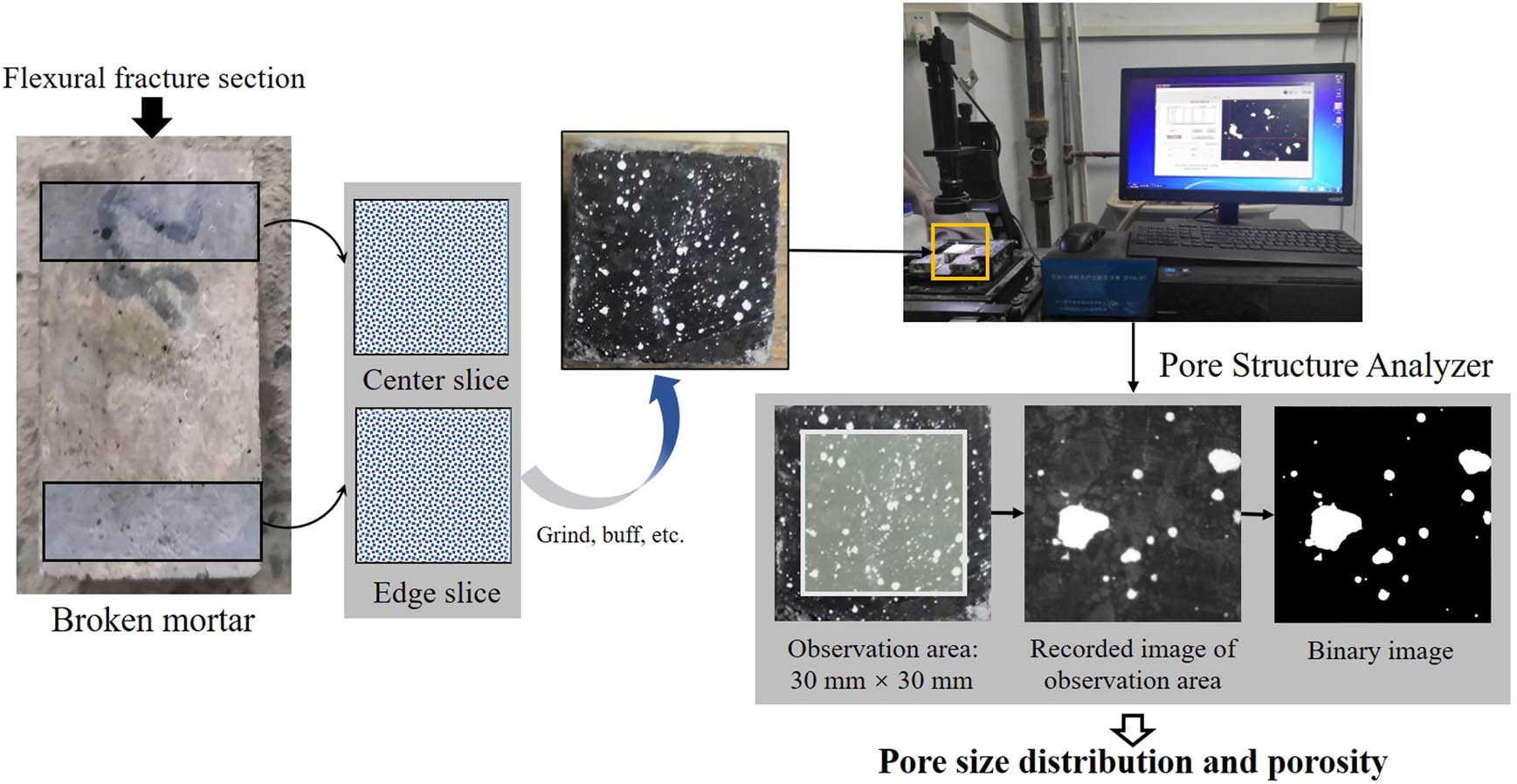
Pore structure measurement.
2.3.4 Microstructure observation
To understand and explain the NS modification mechanism, the microstructure of the NS-modified cement hydration products was determined using SEM. An ultra-high-resolution field SEM (ZEIZZ EVO, Carl Zeiss AG, Germany) was used to analyze the microstructure of the samples. A mortar specimen was broken to obtain pieces with a volume of <1 cm3, as shown in Figure 3, which were placed in alcohol as SEM observation samples. Small fractured samples at every hydration age were soaked in anhydrous ethanol to stop hydration and dried at 50°C for 12 h. Before the SEM observations, the mortar specimens were dried at 45°C, and the surface was sprayed with gold powder using sputtering.
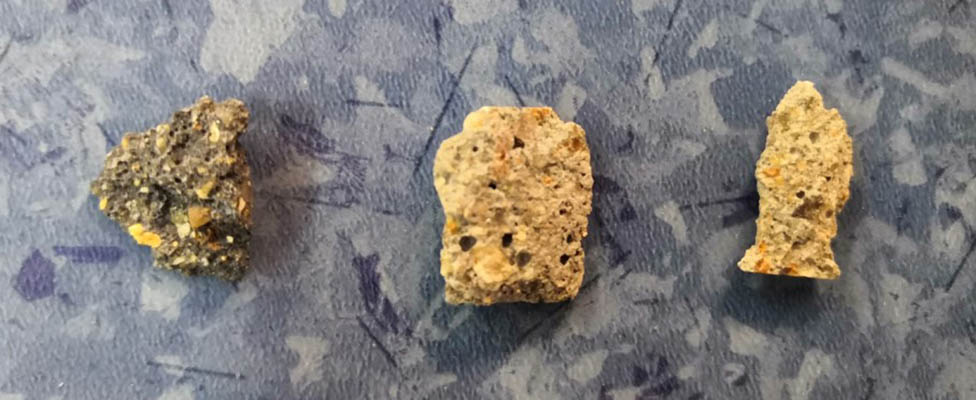
SEM micro-samples.
A general overview of the experimental program is shown in Figure 4; the key parameters of all tests and the type and number of specimens are provided.

General overview of the experimental program.
3 Theoretical relationship model between pore structure and strength
The porosity and pore size distribution significantly affect the capabilities of numerous materials. In particular, they are closely related to the strength of cement mortar [48]. Many scholars have established equations for quantitatively researching the pore structure and strength [49,50,51]. In this study, cement mortar consists of fine aggregate, cement paste and pores. The proportion of aggregate in the mortar is very large, in order to avoid a huge amount of calculation aggregate; aggregate and cement paste are unified into a mortar matrix. The cement mortar was equivalent to a two-phase composite composed of the mortar matrix and pores. The mortar matrix strength index values of mortar specimens S0, S1 and S2 were derived based on the strength test and pore structure measurement results for the NS sol-modified mortar. The calculation method reported by Luping [51] and Jin et al. [52] was referenced.
The parallel porous body model was used to research the pore structure and strength quantitatively, and to determine the effect of the pore size distribution. In addition, the pores were simplified to round shapes in the two-dimensional model. The equivalent relationship between the two models is shown in Figure 5. The two-phase model is equivalent to a calculation model composed of n porous bodies. In each porous body, the pores are considered to have a consistent size, where r n is the pore size of the nth porous body, and the nth porous body is represented by B n .
![Figure 5
Equivalence of two-phase round pore model and parallel porous body model [48].](/document/doi/10.1515/ntrev-2022-0139/asset/graphic/j_ntrev-2022-0139_fig_005.jpg)
Equivalence of two-phase round pore model and parallel porous body model [48].
For the two-phase model, the relationship between porosity v and effective area ratio A m can be calculated using equation (1). According to Griffith’s theory, the critical stress, σ c, when the porous body fractures can be expressed as equation (2), where K indicates the strength of the mortar matrix. The deduction of K is based on references [51,52]. It is defined as the matrix strength index in this article.
For the parallel model, during the compressive loading of the mortar, the force of each porous body gradually increases, and the effective area of B 1 with the largest radius r 1 has the smallest value. When B 1 is destroyed, there is a correlation between nominal stress σ, load P 1, and matrix strength index K, as shown in equation (3), and the effective area ratio would increase from A m1 to A m2 equation (4). Moreover, the steps are repeated until all the porous bodies are damaged, and theoretical strength f c can be calculated according to equation (5).
Matrix strength index K is difficult to obtain through experiments. In this study, experimental data and a computer program were used to determine K. Furthermore, a quantitative study of the pore structure and strength of the NS sol-modified mortar was performed based on the test results and calculation results.
4 Results and discussion
4.1 Mortar fluidity
Each group of mortar fluidity values of S0, S1 and S2 are shown in Figure 6. These results indicated that the mortar fluidity decreased as the NS content increased. At NS contents of 1.5 and 3%, the mortar fluidity was considerably reduced. Relative to S0, the mortar fluidity was reduced by 16.3 and 36.9% with NS contents of 1.5 and 3%, respectively. Clearly, the addition of NS sol was detrimental to the workability of the mortar.
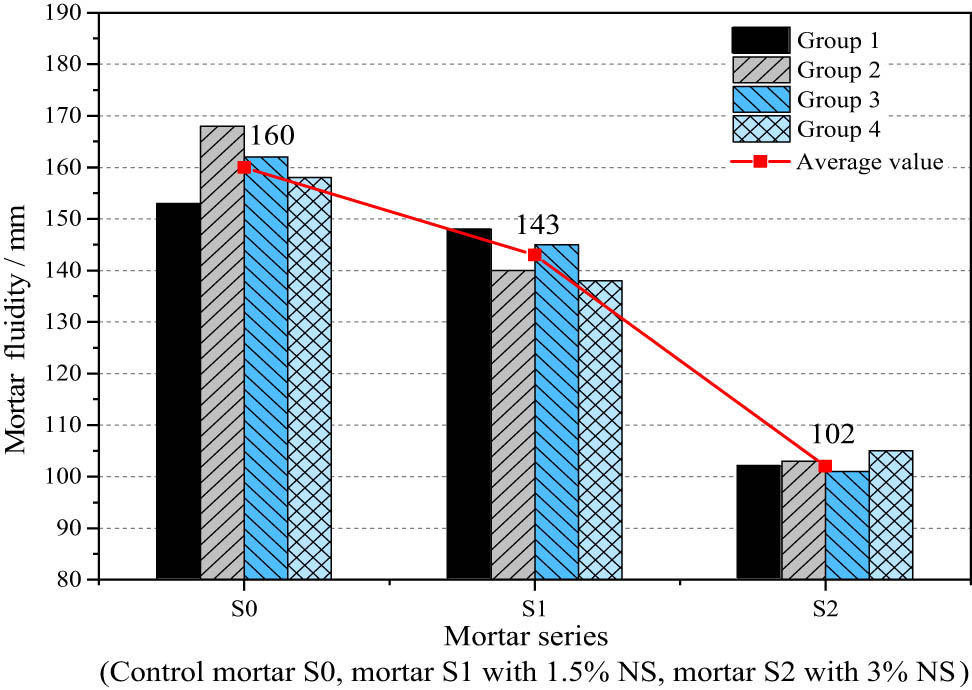
Mortar fluidity test results.
The negative impact of NS on the workability of cementitious materials has been recognized [53,54]. It is due to the fact that the surfaces of NS particles have a powerful attraction and high specific surface area, which allow them to adsorb water molecules in the mixing water on their surfaces. Thus, the reduced free water in the fresh cement mortar leads to reduced mortar fluidity [23].
4.2 Mortar strength
The compressive strengths of the NS-modified mortar (S1 and S2) and control mortar (S0) are shown in Figure 7. The compressive strength test results indicated that mixing NS sol into the mortar increased its compressive strength. Compared to S0, the compressive strength of S1 was increased by 47.6% at 3 days, 32.8% at 7 days, 21.7% at 14 days, and 16.1% at 28 days. The compressive strength of S2 was increased by 60.2% at 3 days, 48.8% at 7 days, 35.1% at 14 days, and 28.6% at 28 days. The compressive strength of the mortar mixed with NS sol was significantly improved.
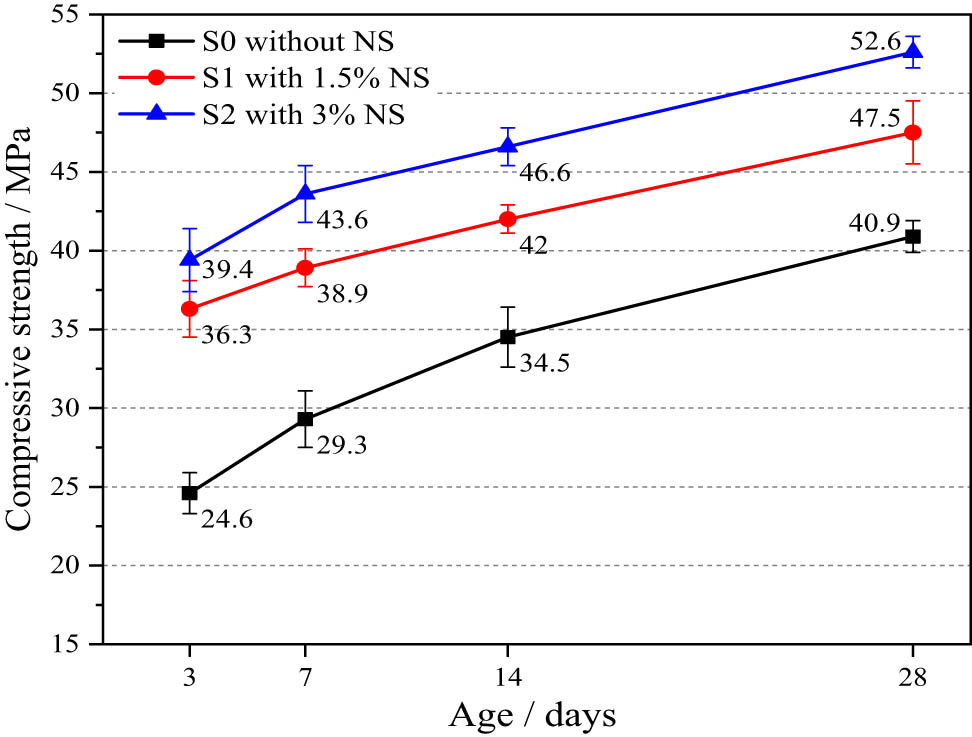
Development of compressive strength.
The flexural strengths of the NS-modified mortars (S1 and S2) and control mortar (S0) are shown in Figure 8. Consistent with the compressive strength test results, the flexural strength increased when the NS sol was mixed into the mortar. Compared to S0, the flexural strength of S1 was increased by 22.6% at 3 days, 19.3% at 7 days, 12.8% at 14 days, and 6.5% at 28 days. The flexural strength of S2 was increased by 32.5% at 3 days, 27.8% at 7 days, 15.9% at 14 days, and 10.7% at 28 days. Likewise, when the NS sol dosage was increased, the improvement in the flexural strength was more obvious.
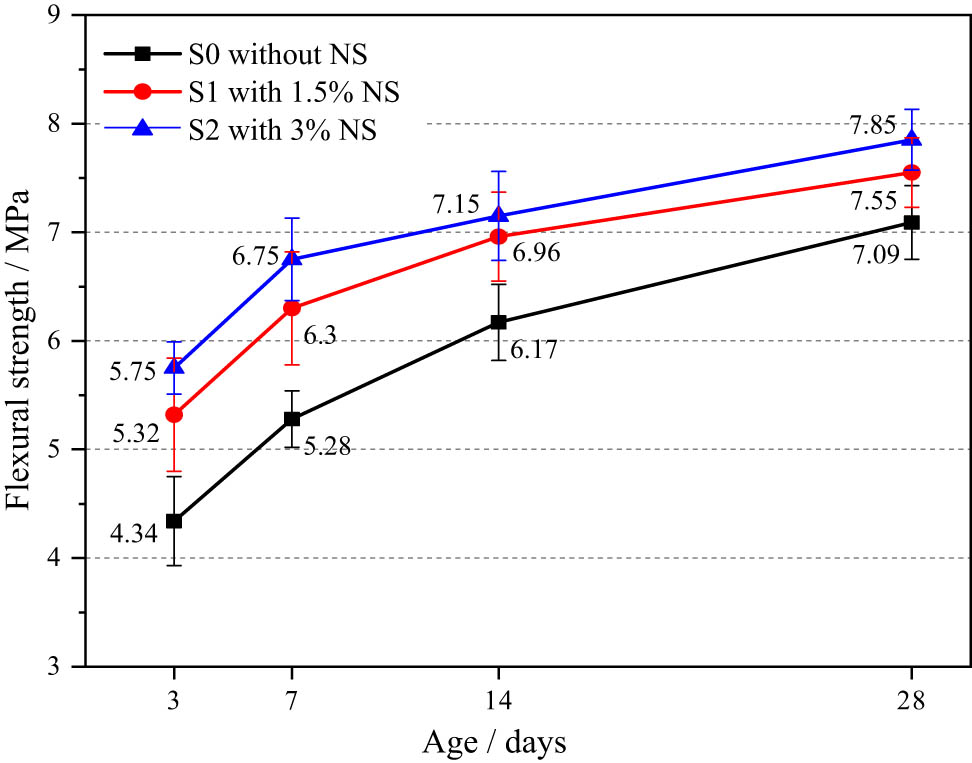
Development of flexural strength.
As the age increased, the compressive and flexural strength enhancement effects decreased. Clearly, the NS sol had a greater effect on the early compressive strength of the mortar. At 3 days, the compressive strength enhancement effect of 3% NS was more than 60%, and the effect of 1.5% NS was more than 45%. In addition, the NS modification had a smaller enhancement effect on the flexural strength than on the compressive strength. This showed that NS had no significant enhancement effect on the mortar toughness.
The test results for the mortar mechanical properties indicated that the cement mortar strength was enhanced by the modification with the NS sol, with a more significant enhancement effect on the early (3 and 7 days) strength. NS has greater pozzolanic activity than silica fume [12], which meanwhile promotes the hydration process inside the cement matrix. Therefore, the NS had an excellent enhancement effect on the early strength of the mortar. Moreover, the microstructure of the cement matrix could be enhanced by the filling effect, where nanoscale silica particles in the NS sol filled the micro-nano-pores in the cementitious material. Thus, the microstructure of the NS-modified cementitious material was denser, and the performance was excellent.
4.3 Pore structure
Binary images of the pore distributions of samples S0, S1, and S2 are shown as Figure 9, in which the white areas indicate the pores, and the black area is the mortar matrix. It is obvious that the shape and distribution of the pores in the edge and center slices are consistent, and the number of pores increases with an increase in the NS sol dosage.
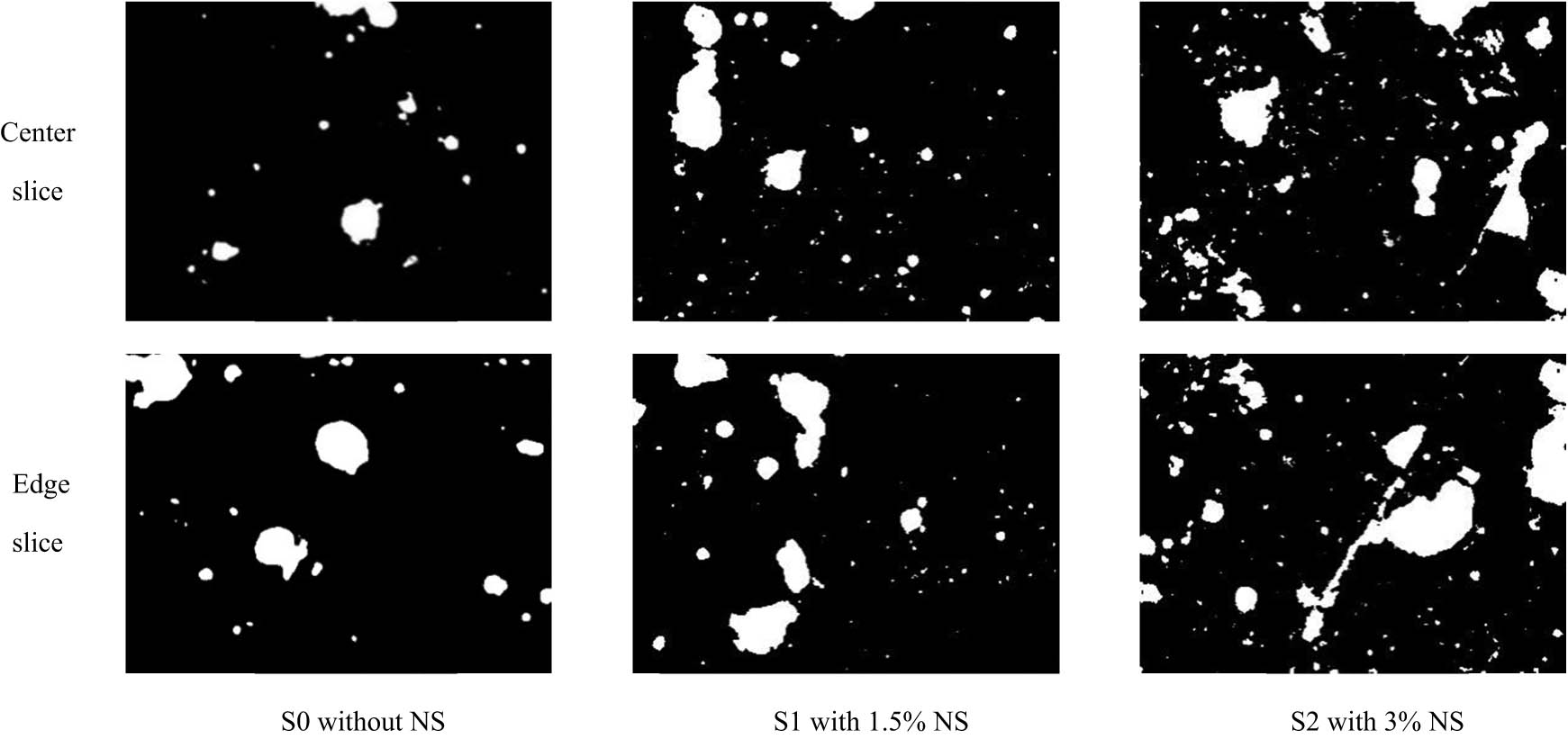
Binary images of sample pore distributions.
The porosity values were calculated for center and edge slices of S0, S1, and S2, which are shown in Figure 10. A comparison of the porosities of the center and edge slices of S0 and S1 shows that there is not much difference. The porosities of S2 were 11.92% (center slice) and 10.35% (edge slice). Thus, the porosity of the center slice was 15% greater than that of the edge slice. Based on the average porosity of the center and edge slice, the porosities of S1 and S2 were 26.5 and 72.3% greater than that of S0, respectively. Undoubtedly, as the NS content increased, the mortar porosity increased.
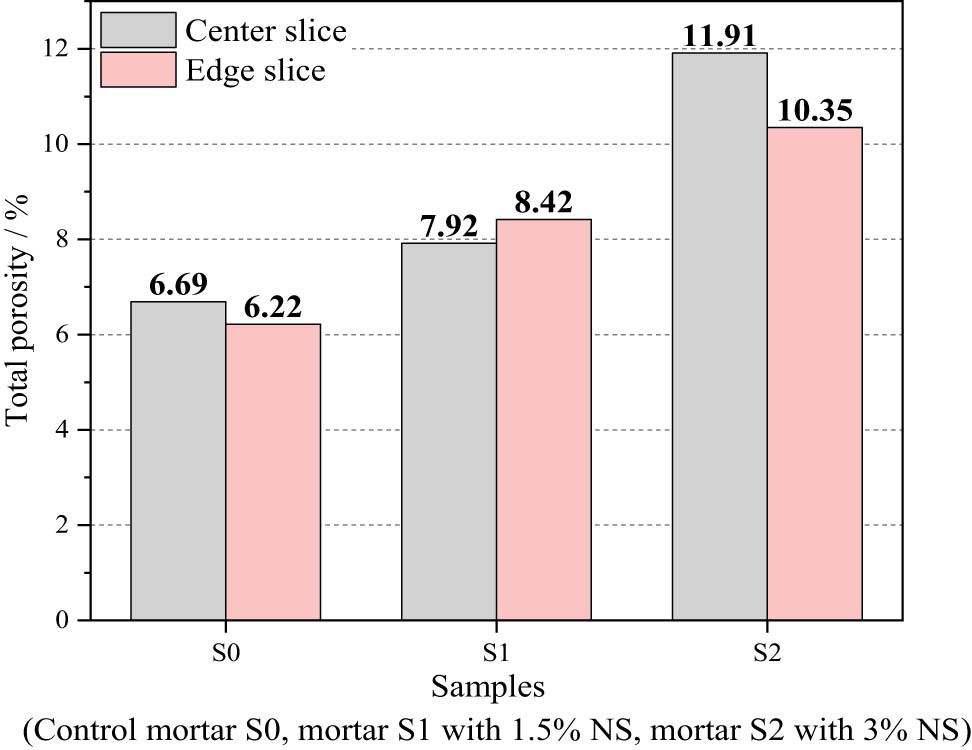
Total porosity of hardened mortar.
The pore size distributions and corresponding porosities are shown in Figure 11(a) and (b). These results indicate that the pore size distribution trends for all samples were almost identical. In the pore radius range of 1–50 μm, as the pore size increases, the corresponding porosity increases. The corresponding porosity fluctuates in the pore radius range of 50–300 μm. The corresponding porosity finally peaks in the pore radius range of 300–1,000 μm. The peak porosity of the center slice was 1.75–2%, and the peak porosity of the edge slice was 1.75–3%. S2 edge slices had the highest peak porosity of 2.9%. In addition, the radii of the pores tested in the S0 and S2 slices hardly exceeded 1,000 μm, whereas the radii of some pores in the S2 center and edge slices tested were larger than 1,000 μm.
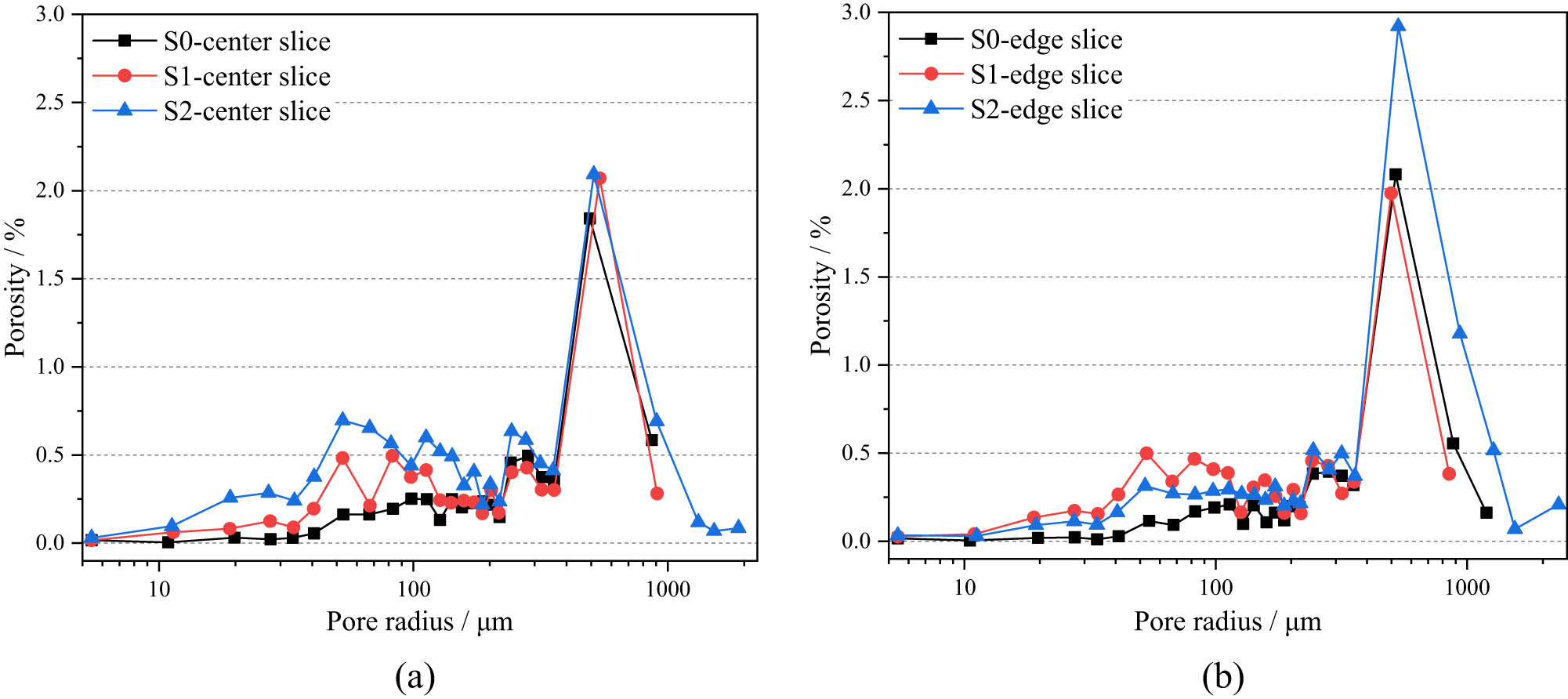
Pore size distributions: (a) center slice and (b) edge slice.
The cumulative porosity curves of the six test slices are shown in Figure 12(a)–(c). For samples S0 and S1, the trends for the curves of the edge and center slices are consistent, whereas the curves of the edge and center slices of sample S2 are very different. In Figure 12(a), the cumulative porosity percentage of the 100 μm pores is approximately 10%, whereas, in Figure 12(b), the cumulative porosity percentage of the 100 μm pores is approximately 30%. These results show that the number of micropores (1–100 μm) in sample S1 was greater than those in S0. In Figure 12(c), at the 100 μm pore size, the cumulative porosity percentage of the S2 center slice is approximately 30%, and that of the S2 edge slice is approximately 18%. In addition, the total porosity of S2 is 10–12%, which indicates that there was a greater number of micropores (1–100 μm) and macropores (>100 μm) in the S2 sample.
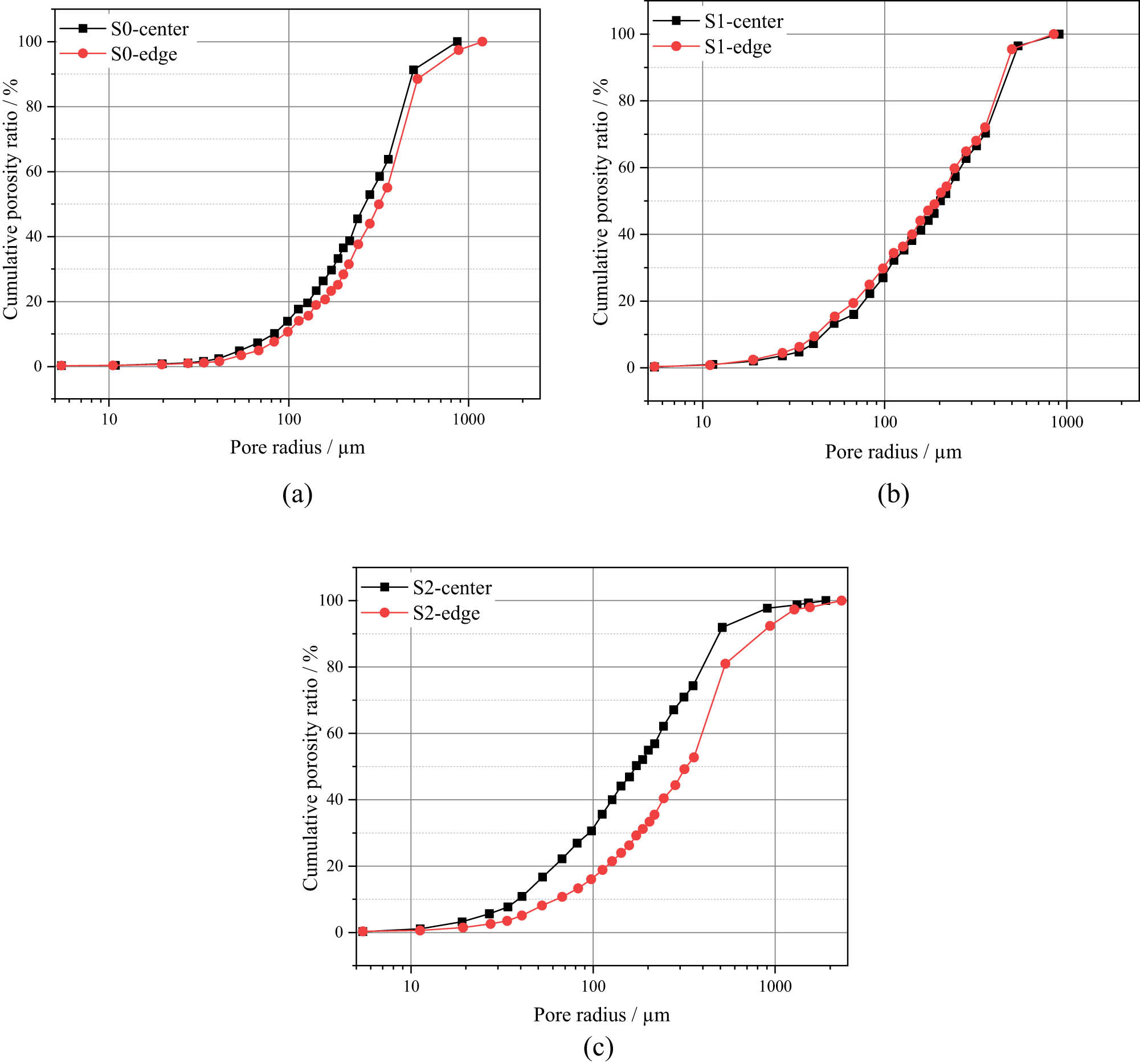
Cumulative porosity ratio of test samples: (a) S0 without NS, (b) S1 with 1.5% NS, and (c) S2 S1 with 3% NS.
In summary, the porosity increased with the NS sol dosage. This result was consistent with the results reported by Feng et al. [23]. When the content of large capillary pores (0.05–10 μm) in an NS sample was higher than expected, they suggested that the density of NS hydration products led to their diffusion being hindered, which produced more pore structures [55]. The porosity and pore distribution were investigated using the linear traverse method. Compared with the reference sample, there was an increase in the number of micropores with radii of 1–100 μm in the mortar sample with a dosage of 1.5% NS, whereas both the micropores (1–100 μm) and macropores (>100 μm) increased in the mortar sample with the dosage of 3% NS. The pore structure has significant effects on the mechanical properties of mortar and other cementitious materials [56]. In this study, the relationship between the pore structure and strength of the NS sol-modified cement mortar was investigated using theoretical calculations.
4.4 SEM results
Figure 13 shows microstructure images of three hardened mortar samples. The microstructure of the C–S–H gel of the three group specimens is critically different, and the difference in compactness is resulting from the shape and size of the particles. In the control mortar, Figure 13(a) and (b), hydrated cement paste is an accumulation composed of angular particles typically in the size range from 50 to 200 nm. It can be seen that the reference sample has a relatively loose microstructure with a number of large voids as marked in the image.
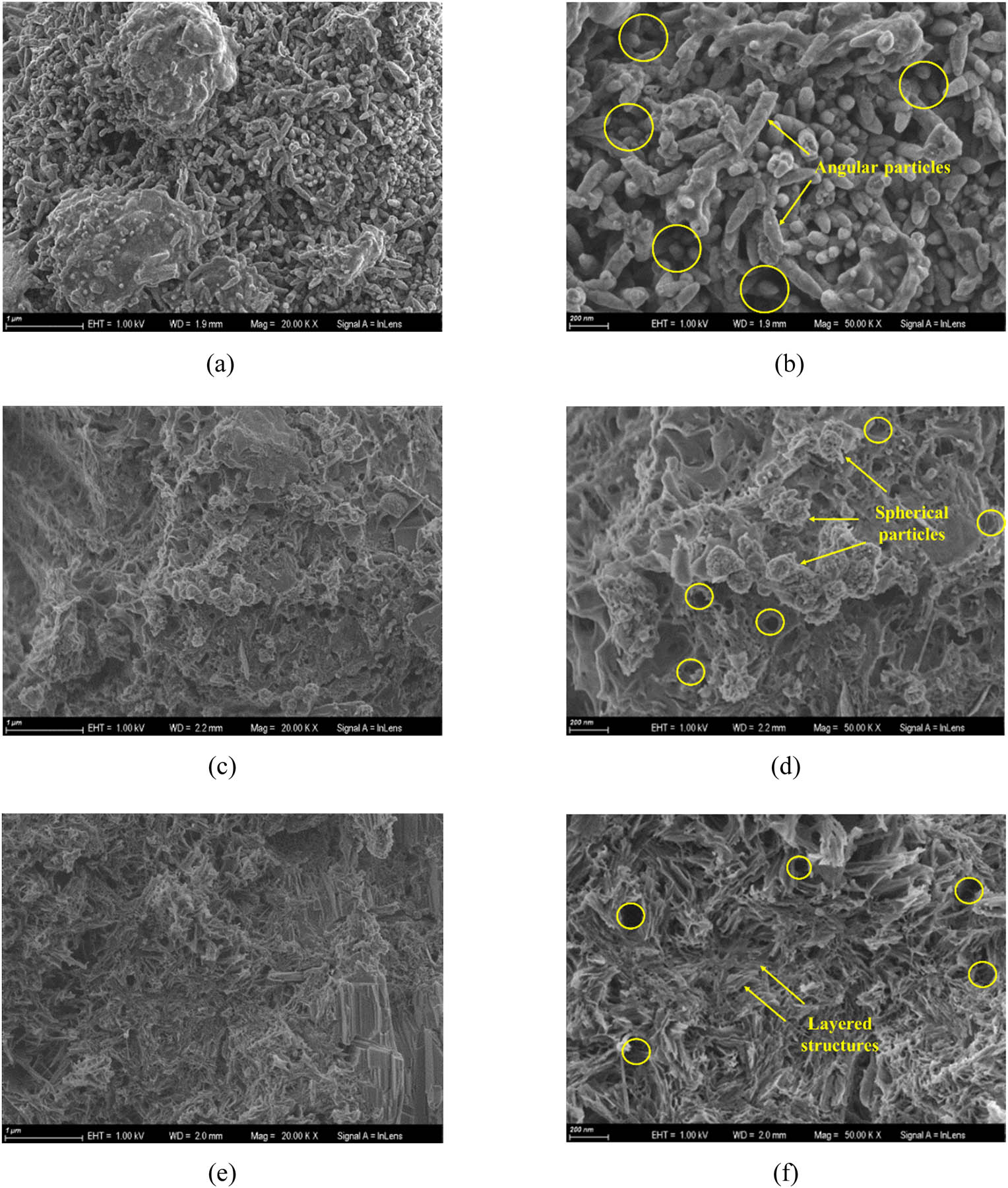
Microstructure images of three mortar samples. (a) S0 20,000×, (b) S0 50,000×, (c) S1 20,000×, (d) S1 50,000×, (e) S2 20,000×, and (f) S2 50,000×.
In the microstructure of S1, Figure 13(c) and (d), there are spherical particles with a size of 100–200 nm distributed on the hardened cement paste, and the cement paste is composed of some dense layered structures; C–S–H spherical particles were formed on the surface of hydration products. In the microstructure of S2, Figure 13(e) and (f), hardened cement paste is almost entirely composed of layered structures, and there is a reticular network shape. As shown in images (d) and (f), both the S1 and S2 were able to densify the microstructure and the proportion of capillary pores is significantly reduced, as indicated by the yellow circles. It is obvious that the influence of the higher dosage of NS on the microscopic morphology of C–S–H is significant, the effect of NS on the crystal morphology of C–S–H causes the refinement of interlayer pores, which is the key to improving the strength of mortar. These results were close to those reported by Feng et al. [23] and Hou et al. [26,55]. In addition, the setting time of NS concrete is shortened, the slump is reduced, and the shrinkage is improved owing to the high activity and nucleation of NS [57]. In summary, the incorporation of NS significantly improved the microscopic properties of NS-modified cement mortar.
4.5 Calculation and result analysis
Because of the high specific surface ratio, the free dispersed water in the mixture existing among the particles of cement and NS will be decreased by the high specific surface ratio of the nanoparticle. As a result, the addition of NS into the mortar can greatly change the properties of the fresh mortar [15], this change will lead to the increase of mesoscopic pores (micron-scale pores) [23]. Although NS enhances the strength of mortar, the increase in micron porosity may be a critical issue in the application of NS-modified mortar. Therefore, the quantitative relationship between micron porosity and strength under the influence of NS is calculated, and this research reveals the effect of NS limited by micropores on the strength of mortar
The strength, porosity, and pore size distribution of the NS sol-modified and control mortars were measured in the previously discussed experiments. In the calculation, the measured pores were subdivided into six size ranges according to the pore radii: <50, 50–100, 100–200, 200–500, 500–1,000, and >1,000 µm. In addition, because the pore structure distribution results were from six mortar slices, the relationship between the pore structure and strength in each of the three mortar groups was calculated using the center and edge slices. The parameters used for the quantitative calculations for the six mortar slices are listed in Table 4, where r i is the average pore size, V i is the porosity, V is the total porosity, and f c is the compressive strength. The matrix strength index, K, values of the NS sol-modified mortar and control mortar were calculated using equations (1)–(5), the compiled computer program, and the calculation parameters from the strength test and pore structure measurement. The K value has been repeatedly calculated, and the results show that K is a constant related to pore distribution and strength.
Parameters for quantitative calculations
| Size range | S0-center | S0-edge | S1-center | S1-edge | S2-center | S2-edge | ||||||
|---|---|---|---|---|---|---|---|---|---|---|---|---|
| r i | V i | r i | V i | r i | V i | r i | V i | r i | V i | r i | V i | |
| (μm) | (μm) | (%) | (μm) | (%) | (μm) | (%) | (μm) | (%) | (μm) | (%) | (μm) | (%) |
| <50 | 19.6 | 0.16 | 16.5 | 0.10 | 26.4 | 0.57 | 24.1 | 0.79 | 23.6 | 1.29 | 21.4 | 0.53 |
| 50–100 | 74.3 | 0.77 | 76.2 | 0.57 | 75.6 | 1.56 | 70.6 | 1.71 | 68.6 | 2.36 | 70.4 | 1.13 |
| 100–200 | 146.1 | 1.29 | 142.9 | 0.90 | 152.3 | 1.53 | 141.3 | 1.62 | 138.7 | 2.56 | 143.8 | 1.57 |
| 200–500 | 344.6 | 3.89 | 268.5 | 1.86 | 365.7 | 1.91 | 345.7 | 3.91 | 263.8 | 2.65 | 270.3 | 2.23 |
| 500–1,000 | 866.4 | 0.58 | 569.4 | 2.64 | 863.2 | 2.35 | 849.7 | 0.38 | 573.8 | 2.78 | 608.3 | 4.10 |
| >1,000 | None | 1194.7 | 0.16 | None | None | 1514.9 | 0.27 | 1471.0 | 0.79 | |||
| V (%) | 6.69 | 6.22 | 7.92 | 8.42 | 11.91 | 10.35 | ||||||
| f c (MPa) | 40.9 | 47.5 | 52.6 | |||||||||
In the calculation, the preliminary range of K was determined through a trial calculation, where K was an integer from 1 to 7. Then, the corresponding compressive strength was calculated. The K-compressive strength correlation curves of the six mortar slices were obtained and are shown in Figure 14 (a) and (b). The compressive strength had an obvious positive linear correlation with matrix strength index K. In general, the linear intercepts of all the K-compressive strength correlation curves were in the range of 0.3–0.5, which showed that there was little difference. Thus, the linear intercept was ignored in this study. The slope of the K-compressive strength correlation curve was used to represent the ratio of compressive strength f c to matrix strength index K. For many materials, there is a curvilinear relationship between a and the porosity. The relationship between the f c /K and total porosity values of the tested slices is shown in Figure 15. The primary issue can be summarized as follows: when the porosity increases, the curve slopes decrease. It was obvious that an increase in porosity decreased the strength of the mortar. In addition, the trend for the NS sol-modification effect was a curvilinear relationship, which indicated that the strength of the NS-modified mortar would be greater if the porosity of the three groups was consistent.
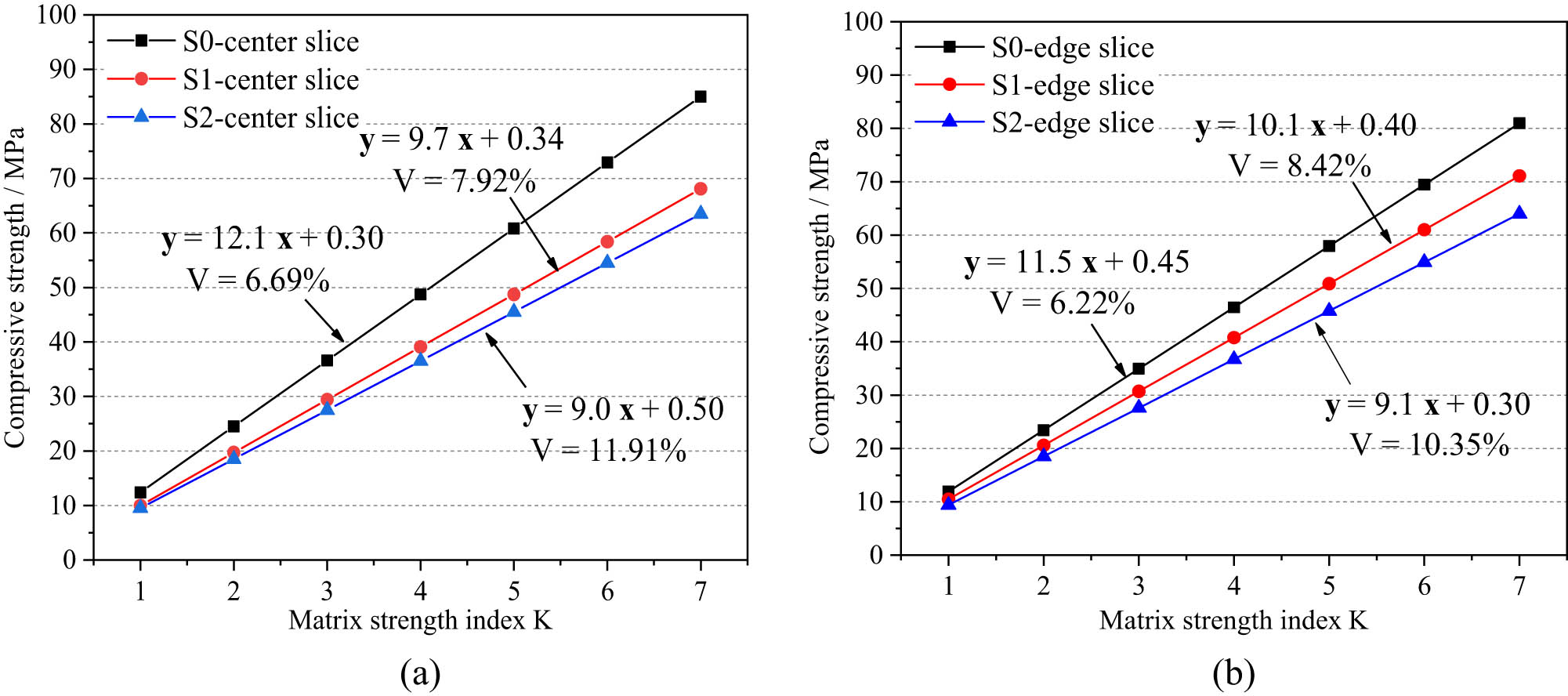
Relationship between K and compressive strength. (a) Center slice and (b) edge slice.
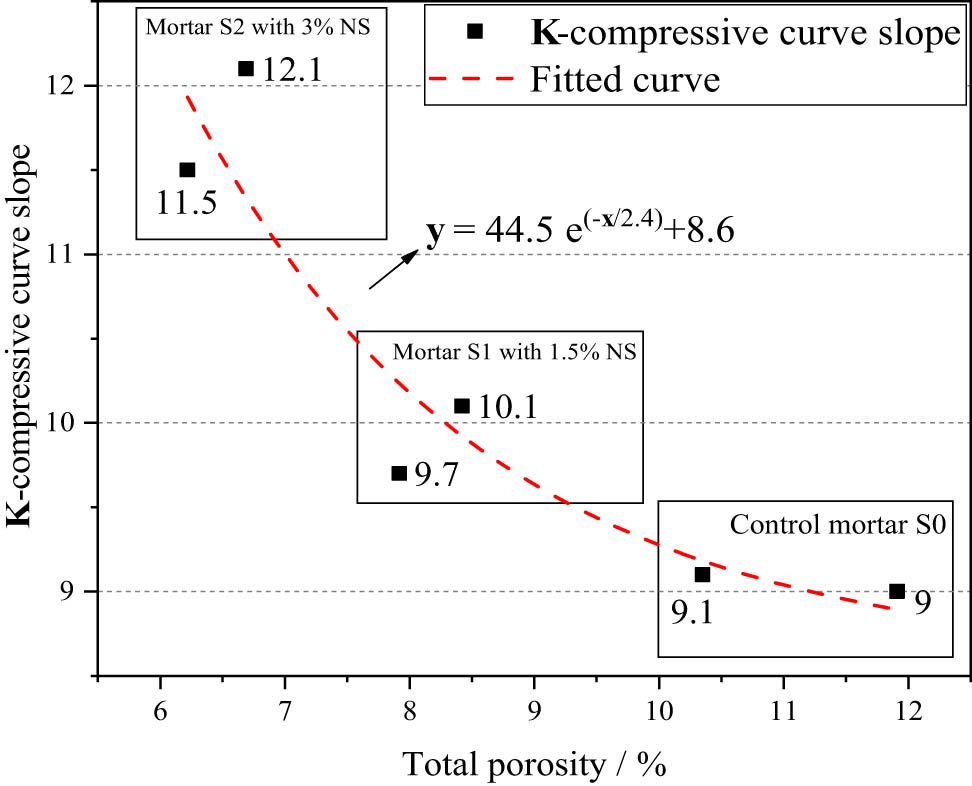
Trend of mortar/matrix strength ratio.
The measured compression strengths of mortar specimens S0, S1, and S2 were 40.9, 47.5, and 52.6 MPa, respectively. In addition to the K-compressive strength curves, the values of the matrix strength index S0, S1, and S2 were 3.52–3.85, 4.66–4.87, and 5.75–5.79, respectively. This study further showed that the effect of the NS sol on the mortar matrix strength became more significant when the amount of NS sol increased.
The trends for the total porosity, compressive strength, and matrix strength index K are shown in Figure 16. It was found that the total porosity, compressive strength, and matrix strength increased with an increase in the NS sol dosage. In general, the porosity and strength of solid materials have an inverse relationship, and the strength depends on the solid part of the material. Hu et al. [48] studied the porosity and strength of carbon nanotube-modified mortar and found that a large increase in porosity led to a decrease in mortar strength. In this study, it was obvious that the increase in porosity was not sufficient to affect the mortar strength negatively. By contrast, with NS contents of 1.5 and 3%, the compressive strength was enhanced by 16.1 and 28.6%, respectively, and K increased by 29.3 and 56.6%, respectively. The results suggested that the increase in the strength of the NS-modified mortar was limited by the increase in porosity.
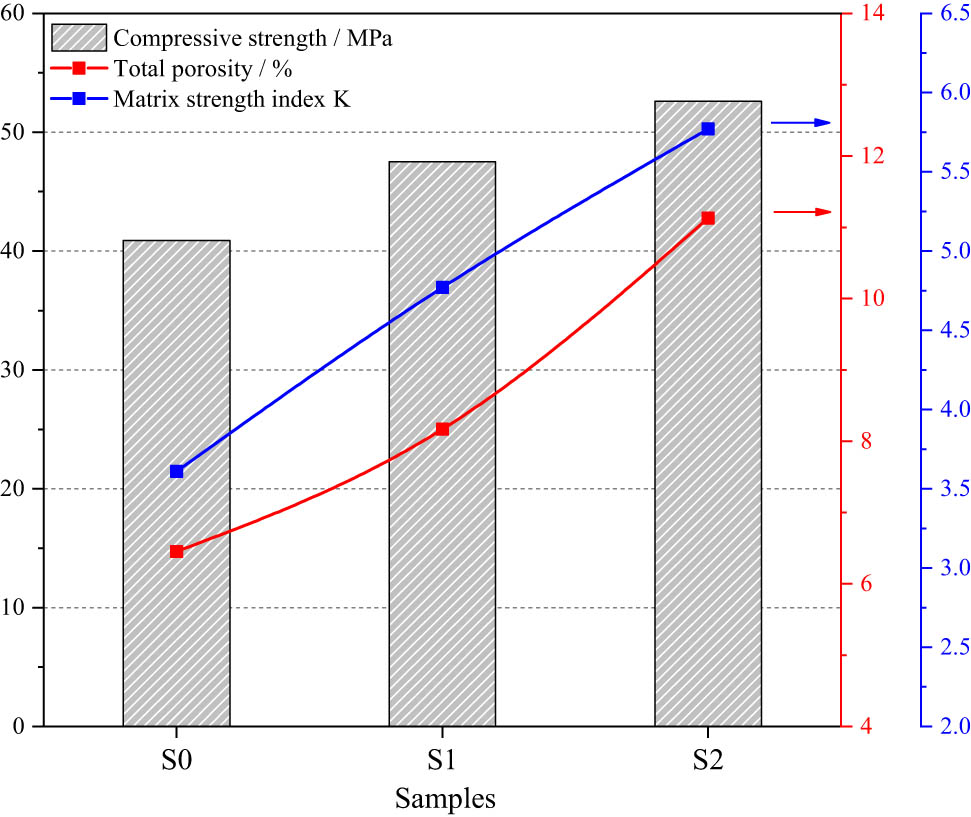
Trend curves of compressive strength, total porosity, and matrix strength index K.
5 Conclusion
This study focused on the quantitative relationship between the pore structure and strength of this NS sol-modified mortar. The pore structure distribution is analyzed using PSA, and the microstructure of the modified mortar was investigated using SEM; the fluidity and strength of mortar are also studied. Based on the above tests, a theoretical calculation of the relationship between the strength and pore structure was performed. The main conclusions of the research can be summarized as follows:
It was found that NS sol increased the porous structure in the modified mortar. Relative to the control mortar, with NS contents of 1.5 and 3%, the porosity was increased by 26.5 and 72.3%, respectively. The micropores (1–100 μm) in the mortar sample with the 1.5% NS dosage were increased, while the micropores (1–100 μm) and macropores (>100 μm) of the mortar sample with the 3% NS dosage were both increased.
The morphology of the hydration products of mortar cement changes with the increase of NS sol content. In the NS sol-modified mortar, C–S–H spherical particles were formed on the surface of hydration products, and the effect of NS on the crystal morphology of C–S–H causes the refinement of pores, which reflects the influence of the high pozzolanic activity and filling effect of NS in the process of cement hydration. The effect of NS on the microstructure of cement mortar is the mechanism of strength improvement.
NS significantly improved the matrix strength of the mortar, and the ratio of the mortar strength to matrix strength showed a negative correlation with the increase in porosity. The mortar matrix strength index, K, was calculated using a simplified theoretical model. The slope of the K-compressive strength curve decreased with increasing porosity, which meant that the ratio of the compressive strength to the mortar matrix strength was affected by the porosity. With NS contents of 1.5 and 3%, K was increased by 29.3 and 56.6%, respectively.
The relationship between the strength and pore structure was discussed. This research showed that the mechanical properties, matrix strength, and porosity of the NS sol-modified mortar were improved. Calculation results showed that the increase in porosity was unfavorable for an increase in the mortar strength, and the enhancement effect of NS on the mortar matrix is greater than the reduction effect of increasing porosity on the strength.
In summary, the quantitative relationship between the micron-scale pores and strength of NS sol-modified mortar was studied and discussed. More research studies should be conducted on the pore size distribution for digging into the durability evolution mechanism.
-
Funding information: The authors would like to acknowledge the financial support received from the National Natural Science Foundation of China (Grant No. 52179145, U2040224, 52130901), Scientific and Technological Research Project in Henan province (Grant No.222300420081), the Program for Science and Technology Innovation Talents in Universities of Henan Province (21HASTIT013), and Open Research Fund Program of State key Laboratory of Hydroscience and Engineering (sklhse-2022-c-01).
-
Author contributions: All authors have accepted responsibility for the entire content of this manuscript and approved its submission.
-
Conflict of interest: The authors state no conflict of interest.
-
Data availability statement: The data that support the findings of this study are available from the corresponding author, [J.W.], upon reasonable request.
References
[1] Yoo DY, Oh T, Kang MC, Kim MJ, Choi H-J. Enhanced tensile ductility and sustainability of high-strength strain-hardening cementitious composites using waste cement kiln dust and oxidized polyethylene fibers. Cem Concr Comp. 2021;120:104030.10.1016/j.cemconcomp.2021.104030Search in Google Scholar
[2] Kolawole JT, Babafemi AJ, Fanijo E, Chandra Paul S, Combrinck R. State-of-the-art review on the use of sugarcane bagasse ash in cementitious materials. Cem Concr Comp. 2021;118:103975.10.1016/j.cemconcomp.2021.103975Search in Google Scholar
[3] Gao Z, Zhang P, Wang J, Wang K, Zhang T. Interfacial properties of geopolymer mortar and concrete substrate: Effect of polyvinyl alcohol fiber and nano-SiO2 contents. Constr Build Mater. 2022;315:125735.10.1016/j.conbuildmat.2021.125735Search in Google Scholar
[4] Oh JA, Zhuge Y, Araby S, Wang R, Yu H, Fan W, et al. Cement nanocomposites containing montmorillonite nanosheets modified with surfactants of various chain lengths. Cem Concr Comp. 2021;116:103894.10.1016/j.cemconcomp.2020.103894Search in Google Scholar
[5] Wang J, Xu Y, Wu X, Zhang P, Hu S. Advances of graphene- and graphene oxide-modified cementitious materials. Nanotechnol Rev. 2020;9(1):465–77.10.1515/ntrev-2020-0041Search in Google Scholar
[6] Mu S, Yue J, Wang Y, Feng C. Electrical, piezoresistive and electromagnetic properties of graphene reinforced cement composites: a review. Nanomaterials. 2021;11(12):3220.10.3390/nano11123220Search in Google Scholar PubMed PubMed Central
[7] Abhilash PP, Nayak DK, Sangoju B, Kumar R, Kumar V. Effect of nano-silica in concrete; a review. Constr Build Mater. 2021;278.10.1016/j.conbuildmat.2021.122347Search in Google Scholar
[8] Liu C, He X, Deng X, Wu Y, Zheng Z, Liu J, et al. Application of nanomaterials in ultra-high performance concrete: A review. Nanotechnol Rev. 2020;9(1):1427–44.10.1515/ntrev-2020-0107Search in Google Scholar
[9] Ren Z, Liu Y, Yuan L, Luan C, Wang J, Cheng X, et al. Optimizing the content of nano-SiO2, nano-TiO2 and nano-CaCO3 in Portland cement paste by response surface methodology. J Build Eng. 2021;35:102073.10.1016/j.jobe.2020.102073Search in Google Scholar
[10] Xu J, Wang B, Zuo J. Modification effects of nanosilica on the interfacial transition zone in concrete: A multiscale approach. Cem Concr Comp. 2017;81:1–10.10.1016/j.cemconcomp.2017.04.003Search in Google Scholar
[11] Stefanidou M, Papayianni I. Influence of nano-SiO2 on the Portland cement pastes. Compos Part B-Eng. 2012;43(6):2706–10.10.1016/j.compositesb.2011.12.015Search in Google Scholar
[12] Byung-Wan J, Chang-Hyun K, Ghi-ho T, Jong-Bin P. Characteristics of cement mortar with nano-SiO2 particles. Constr Build Mater. 2007;21(6):1351–5.10.1016/j.conbuildmat.2005.12.020Search in Google Scholar
[13] Huang Q, Zhu X, Zhao L, Zhao M, Liu Y, Zeng X. Effect of nanosilica on sulfate resistance of cement mortar under partial immersion. Constr Build Mater. 2020;231:117180.10.1016/j.conbuildmat.2019.117180Search in Google Scholar
[14] Zhang M, Li H. Pore structure and chloride permeability of concrete containing nano-particles for pavement. Constr Build Mater. 2011;25(2):608–16.10.1016/j.conbuildmat.2010.07.032Search in Google Scholar
[15] Zhang P, Wan J, Wang K, Li Q. Influence of nano-SiO2 on properties of fresh and hardened high performance concrete: A state-of-the-art review. Constr Build Mater. 2017;148:648–58.10.1016/j.conbuildmat.2017.05.059Search in Google Scholar
[16] Yang J, She W, Zuo W, Lyu K, Zhang Q. Rational application of nano-SiO2 in cement paste incorporated with silane: Counterbalancing and synergistic effects. Cem Concr Comp. 2021;118:103959.10.1016/j.cemconcomp.2021.103959Search in Google Scholar
[17] Zhao Z, Kong J, Yang H. Study on frost resistance of nano SiO2 cement concrete. Appl Mech Mater. 2012;198–199:48–51.10.4028/www.scientific.net/AMM.198-199.48Search in Google Scholar
[18] Yu W, Sun L, Wu C, Shao C. Study for frost resistance of cement concrete pavement with NanoSiO2 as admixture. Adv Mater Res. 2014;952:47–50.10.4028/www.scientific.net/AMR.952.47Search in Google Scholar
[19] Supit SWM, Shaikh FUA. Durability properties of high volume fly ash concrete containing nano-silica. Mater Struct. 2014;48:2431–45.10.1617/s11527-014-0329-0Search in Google Scholar
[20] Zhang P, Zhang H, Cui G, Yue X, Guo J, Hui D. Effect of steel fiber on impact resistance and durability of concrete containing nano-SiO2. Nanotechnol Rev. 2021;10(1):504–17.10.1515/ntrev-2021-0040Search in Google Scholar
[21] Li G, Ding Y, Gao TY, Qin YM, Lv YJ, Wang KJ. Chloride resistance of concrete containing nanoparticle-modified polymer cementitious coatings. Constr Build Mater. 2021;14:299.10.1016/j.conbuildmat.2021.123736Search in Google Scholar
[22] Liu X, Feng P, Shu X, Ran Q. Effects of highly dispersed nano-SiO2 on the microstructure development of cement pastes. Mater Struct. 2019;53(1):1–4.10.1617/s11527-019-1431-0Search in Google Scholar
[23] Feng P, Chang H, Liu X, Ye S, Shu X, Ran Q. The significance of dispersion of nano-SiO2 on early age hydration of cement pastes. Mater Des. 2020;186:108320.10.1016/j.matdes.2019.108320Search in Google Scholar
[24] Dongya Y, Qiu F, Fullong Z, Dongmei W, Qinqin Z. Preparation and characterization of nano CaCO3 modified with silica sol and study of its property. Rare Met Mat Eng. 2008;37:351–4.Search in Google Scholar
[25] Yao Y-C, Tseng S-T, Wong DSH. Shelf-life prediction of nano-sol via pH acceleration. J Qual Technol. 2017;49(1):46–63.10.1080/00224065.2017.11918184Search in Google Scholar
[26] Hou P, Kawashima S, Kong D, Corr DJ, Qian J, Shah SP. Modification effects of colloidal nanoSiO2 on cement hydration and its gel property. Compos Part B-Eng. 2013;45(1):440–8.10.1016/j.compositesb.2012.05.056Search in Google Scholar
[27] Flores I, Sobolev K, Torres-Martinez LM, Cuellar EL, Valdez PL, Zarazua E. Performance of cement systems with nano-SiO2 particles produced by using the sol–gel method. Transp Res Rec. 2010;2141(1):10–4.10.3141/2141-03Search in Google Scholar
[28] Zhang X, Song X, Gao R. Effect of nano-silica sol on mechanical properties of cement mortar and the action mechanism. B Chin Ceram Soc. 2014;33:589–92.Search in Google Scholar
[29] Gao M, Xiao J, Zuo S. Multifractal analysis on pore structure of cement-based materials blended with ground limestone and its relationship with permeability. J Chin Ceram Soc. 2019;47:617–24.Search in Google Scholar
[30] Elgalhud AA, Dhir R, Ghataora G. Limestone addition effects on concrete porosity. Cem Concr Comp. 2016;72:222–34.10.1016/j.cemconcomp.2016.06.006Search in Google Scholar
[31] Wang B, Zhao R, Zhang T. Pore structure and durability of cement-based composites doped with graphene nanoplatelets. Mater Exp. 2018;8:149–56.10.1166/mex.2018.1421Search in Google Scholar
[32] Han TS, Zhang X, Kim JS, Chung SY, Lim JH, Linder C. Area of lineal-path function for describing the pore microstructures of cement paste and their relations to the mechanical properties simulated from μ-CT microstructures. Cem Concr Compos. 2018;89:1–17.10.1016/j.cemconcomp.2018.02.008Search in Google Scholar
[33] Jambor J. Pore structure and strength development of cement composites. Cem Concr Res. 1990;20(6):948–54.10.1016/0008-8846(90)90058-6Search in Google Scholar
[34] Guo Y, Zhang T, Liu X, Tian W, Chen P, Wei J, et al. The pore fillability of cementitious materials and its application in predicting compressive strength of gap-graded blended cements. Constr Build Mater. 2018;168:805–17.10.1016/j.conbuildmat.2017.11.091Search in Google Scholar
[35] Shields Y, Garboczi E, Weiss J, Farnam Y. Freeze-thaw crack determination in cementitious materials using 3D X-ray computed tomography and acoustic emission. Cem Concr Compos. 2018;89:120–9.10.1016/j.cemconcomp.2018.03.004Search in Google Scholar
[36] Shen Y, Wang Y, Wei X, Jia H, Yan R. Investigation on meso-debonding process of the sandstone–concrete interface induced by freeze–thaw cycles using NMR technology. Constr Build Mater. 2020;252:118962.10.1016/j.conbuildmat.2020.118962Search in Google Scholar
[37] Sun M, Zou C, Xin D. Pore structure evolution mechanism of cement mortar containing diatomite subjected to freeze-thaw cycles by multifractal analysis. Cem Concr Compos. 2020;114:103731.10.1016/j.cemconcomp.2020.103731Search in Google Scholar
[38] Guan X, Chen J, Qiu J, Gao Y, Gao J. Damage evaluation method based on ultrasound technique for gangue concrete under freezing-thawing cycles. Constr Build Mater. 2020;246:118437.10.1016/j.conbuildmat.2020.118437Search in Google Scholar
[39] Kong D, Du X, Wei S, Zhang H, Yang Y, Shah SP. Influence of nano-silica agglomeration on microstructure and properties of the hardened cement-based materials. Constr Build Mater. 2012;37:707–15.10.1016/j.conbuildmat.2012.08.006Search in Google Scholar
[40] Li D, Niu D, Fu Q, Luo D. Fractal characteristics of pore structure of hybrid Basalt–Polypropylene fibre-reinforced concrete. Cem Concr Compos. 2020;109:103555.10.1016/j.cemconcomp.2020.103555Search in Google Scholar
[41] Fang J, Zhao L, Shi J. Frost resistance and pore structure of concrete incorporated with rubber aggregates and nano-SiO2. Materials. 2021;14:1170.10.3390/ma14051170Search in Google Scholar PubMed PubMed Central
[42] Sobolev K, Flores Vivian I, Torres-Martínez L, Cuéllar E, Valdez P, Zarazua E. Performance of cement systems with nano-SiO2 particles produced using sol–gel method. Mater Res Soc Symp Proc. 2010;1276:10–4.10.1557/PROC-1276-21Search in Google Scholar
[43] GB/T 17671-1999. Method of testing cements-Determination of strength, State Bureau of Building Materials Industry. Chinese National Standard; 1999.Search in Google Scholar
[44] GB/T 2419-2005. Test method of fluidity of cement mortar, State Bureau of Building Materials Industry. Chinese National Standard; 2005.Search in Google Scholar
[45] Jiang J, Feng T, Chu H, Wu Y, Wang F, Zhou W, et al. Quasi-static and dynamic mechanical properties of eco-friendly ultra-high-performance concrete containing aeolian sand. Cem Concr Comp. 2019;97:369–78.10.1016/j.cemconcomp.2019.01.011Search in Google Scholar
[46] SL/T 352- 2020. Test code for hydraylic concrete, Ministry of Water Resources of the People’s Republic of China. Chinese National Standard; 2020.Search in Google Scholar
[47] Wang J, Guo Z, Yuan Q, Zhang P, Fang H. Effects of ages on the ITZ microstructure of crumb rubber concrete. Constr Build Mater. 2020;254:119329.10.1016/j.conbuildmat.2020.119329Search in Google Scholar
[48] Hu S, Xu Y, Wang J, Zhang P, Guo J. Modification effects of carbon nanotube dispersion on the mechanical properties, pore structure, and microstructure of cement mortar. Materials. 2020;13(5):1101.10.3390/ma13051101Search in Google Scholar
[49] Kearsley EP, Wainwright PJ. The effect of porosity on the strength of foamed concrete. Cem Concr Res. 2002;32(2):233–9.10.1016/S0008-8846(01)00665-2Search in Google Scholar
[50] Li Y, Y, C, He X, Wei J, Guo S. Pore volume fractal dimension of fly ash-cement paste and the relationship between the pore structure and strength. J Chin Ceram Soc. 2003;31:774–9.Search in Google Scholar
[51] Luping T. A study of the quantitative relationship between strength and pore-size distribution of porous materials. Cem Concr Res. 1986;16(1):87–96.10.1016/0008-8846(86)90072-4Search in Google Scholar
[52] Jin NG, Jin XY, Guo JF. Relationship modeling of pore structure and strength of concrete. J Zhejiang Univ. 2005;39(11):1680–4.Search in Google Scholar
[53] Nili M, Ehsani A. Investigating the effect of the cement paste and transition zone on strength development of concrete containing nanosilica and silica fume. Mater Des. 2015;75:174–83.10.1016/j.matdes.2015.03.024Search in Google Scholar
[54] Li W, Shaikh FUA, Wang L, Lu Y, Wang B, Jiang C, et al. Experimental study on shear property and rheological characteristic of superfine cement grouts with nano-SiO2 addition. Constr Build Mater. 2019;228:117046.10.1016/j.conbuildmat.2019.117046Search in Google Scholar
[55] Hou P, Qian J, Cheng X, Shah SP. Effects of the pozzolanic reactivity of nanoSiO2 on cement-based materials. Cem Concr Compos. 2015;55:250–8.10.1016/j.cemconcomp.2014.09.014Search in Google Scholar
[56] Kumar R, Bhattacharjee B. Porosity, pore size distribution and in situ strength of concrete. Cem Concr Res. 2003;33(1):155–64.10.1016/S0008-8846(02)00942-0Search in Google Scholar
[57] Zhuang CL, Chen Y. The effect of nano-SiO2 on concrete properties: a review. Nanotechnol Rev. 2019;8(1):562–72.10.1515/ntrev-2019-0050Search in Google Scholar
© 2022 Yaoqun Xu et al., published by De Gruyter
This work is licensed under the Creative Commons Attribution 4.0 International License.
Articles in the same Issue
- Research Articles
- Theoretical and experimental investigation of MWCNT dispersion effect on the elastic modulus of flexible PDMS/MWCNT nanocomposites
- Mechanical, morphological, and fracture-deformation behavior of MWCNTs-reinforced (Al–Cu–Mg–T351) alloy cast nanocomposites fabricated by optimized mechanical milling and powder metallurgy techniques
- Flammability and physical stability of sugar palm crystalline nanocellulose reinforced thermoplastic sugar palm starch/poly(lactic acid) blend bionanocomposites
- Glutathione-loaded non-ionic surfactant niosomes: A new approach to improve oral bioavailability and hepatoprotective efficacy of glutathione
- Relationship between mechano-bactericidal activity and nanoblades density on chemically strengthened glass
- In situ regulation of microstructure and microwave-absorbing properties of FeSiAl through HNO3 oxidation
- Research on a mechanical model of magnetorheological fluid different diameter particles
- Nanomechanical and dynamic mechanical properties of rubber–wood–plastic composites
- Investigative properties of CeO2 doped with niobium: A combined characterization and DFT studies
- Miniaturized peptidomimetics and nano-vesiculation in endothelin types through probable nano-disk formation and structure property relationships of endothelins’ fragments
- N/S co-doped CoSe/C nanocubes as anode materials for Li-ion batteries
- Synergistic effects of halloysite nanotubes with metal and phosphorus additives on the optimal design of eco-friendly sandwich panels with maximum flame resistance and minimum weight
- Octreotide-conjugated silver nanoparticles for active targeting of somatostatin receptors and their application in a nebulized rat model
- Controllable morphology of Bi2S3 nanostructures formed via hydrothermal vulcanization of Bi2O3 thin-film layer and their photoelectrocatalytic performances
- Development of (−)-epigallocatechin-3-gallate-loaded folate receptor-targeted nanoparticles for prostate cancer treatment
- Enhancement of the mechanical properties of HDPE mineral nanocomposites by filler particles modulation of the matrix plastic/elastic behavior
- Effect of plasticizers on the properties of sugar palm nanocellulose/cinnamon essential oil reinforced starch bionanocomposite films
- Optimization of nano coating to reduce the thermal deformation of ball screws
- Preparation of efficient piezoelectric PVDF–HFP/Ni composite films by high electric field poling
- MHD dissipative Casson nanofluid liquid film flow due to an unsteady stretching sheet with radiation influence and slip velocity phenomenon
- Effects of nano-SiO2 modification on rubberised mortar and concrete with recycled coarse aggregates
- Mechanical and microscopic properties of fiber-reinforced coal gangue-based geopolymer concrete
- Effect of morphology and size on the thermodynamic stability of cerium oxide nanoparticles: Experiment and molecular dynamics calculation
- Mechanical performance of a CFRP composite reinforced via gelatin-CNTs: A study on fiber interfacial enhancement and matrix enhancement
- A practical review over surface modification, nanopatterns, emerging materials, drug delivery systems, and their biophysiochemical properties for dental implants: Recent progresses and advances
- HTR: An ultra-high speed algorithm for cage recognition of clathrate hydrates
- Effects of microalloying elements added by in situ synthesis on the microstructure of WCu composites
- A highly sensitive nanobiosensor based on aptamer-conjugated graphene-decorated rhodium nanoparticles for detection of HER2-positive circulating tumor cells
- Progressive collapse performance of shear strengthened RC frames by nano CFRP
- Core–shell heterostructured composites of carbon nanotubes and imine-linked hyperbranched polymers as metal-free Li-ion anodes
- A Galerkin strategy for tri-hybridized mixture in ethylene glycol comprising variable diffusion and thermal conductivity using non-Fourier’s theory
- Simple models for tensile modulus of shape memory polymer nanocomposites at ambient temperature
- Preparation and morphological studies of tin sulfide nanoparticles and use as efficient photocatalysts for the degradation of rhodamine B and phenol
- Polyethyleneimine-impregnated activated carbon nanofiber composited graphene-derived rice husk char for efficient post-combustion CO2 capture
- Electrospun nanofibers of Co3O4 nanocrystals encapsulated in cyclized-polyacrylonitrile for lithium storage
- Pitting corrosion induced on high-strength high carbon steel wire in high alkaline deaerated chloride electrolyte
- Formulation of polymeric nanoparticles loaded sorafenib; evaluation of cytotoxicity, molecular evaluation, and gene expression studies in lung and breast cancer cell lines
- Engineered nanocomposites in asphalt binders
- Influence of loading voltage, domain ratio, and additional load on the actuation of dielectric elastomer
- Thermally induced hex-graphene transitions in 2D carbon crystals
- The surface modification effect on the interfacial properties of glass fiber-reinforced epoxy: A molecular dynamics study
- Molecular dynamics study of deformation mechanism of interfacial microzone of Cu/Al2Cu/Al composites under tension
- Nanocolloid simulators of luminescent solar concentrator photovoltaic windows
- Compressive strength and anti-chloride ion penetration assessment of geopolymer mortar merging PVA fiber and nano-SiO2 using RBF–BP composite neural network
- Effect of 3-mercapto-1-propane sulfonate sulfonic acid and polyvinylpyrrolidone on the growth of cobalt pillar by electrodeposition
- Dynamics of convective slippery constraints on hybrid radiative Sutterby nanofluid flow by Galerkin finite element simulation
- Preparation of vanadium by the magnesiothermic self-propagating reduction and process control
- Microstructure-dependent photoelectrocatalytic activity of heterogeneous ZnO–ZnS nanosheets
- Cytotoxic and pro-inflammatory effects of molybdenum and tungsten disulphide on human bronchial cells
- Improving recycled aggregate concrete by compression casting and nano-silica
- Chemically reactive Maxwell nanoliquid flow by a stretching surface in the frames of Newtonian heating, nonlinear convection and radiative flux: Nanopolymer flow processing simulation
- Nonlinear dynamic and crack behaviors of carbon nanotubes-reinforced composites with various geometries
- Biosynthesis of copper oxide nanoparticles and its therapeutic efficacy against colon cancer
- Synthesis and characterization of smart stimuli-responsive herbal drug-encapsulated nanoniosome particles for efficient treatment of breast cancer
- Homotopic simulation for heat transport phenomenon of the Burgers nanofluids flow over a stretching cylinder with thermal convective and zero mass flux conditions
- Incorporation of copper and strontium ions in TiO2 nanotubes via dopamine to enhance hemocompatibility and cytocompatibility
- Mechanical, thermal, and barrier properties of starch films incorporated with chitosan nanoparticles
- Mechanical properties and microstructure of nano-strengthened recycled aggregate concrete
- Glucose-responsive nanogels efficiently maintain the stability and activity of therapeutic enzymes
- Tunning matrix rheology and mechanical performance of ultra-high performance concrete using cellulose nanofibers
- Flexible MXene/copper/cellulose nanofiber heat spreader films with enhanced thermal conductivity
- Promoted charge separation and specific surface area via interlacing of N-doped titanium dioxide nanotubes on carbon nitride nanosheets for photocatalytic degradation of Rhodamine B
- Elucidating the role of silicon dioxide and titanium dioxide nanoparticles in mitigating the disease of the eggplant caused by Phomopsis vexans, Ralstonia solanacearum, and root-knot nematode Meloidogyne incognita
- An implication of magnetic dipole in Carreau Yasuda liquid influenced by engine oil using ternary hybrid nanomaterial
- Robust synthesis of a composite phase of copper vanadium oxide with enhanced performance for durable aqueous Zn-ion batteries
- Tunning self-assembled phases of bovine serum albumin via hydrothermal process to synthesize novel functional hydrogel for skin protection against UVB
- A comparative experimental study on damping properties of epoxy nanocomposite beams reinforced with carbon nanotubes and graphene nanoplatelets
- Lightweight and hydrophobic Ni/GO/PVA composite aerogels for ultrahigh performance electromagnetic interference shielding
- Research on the auxetic behavior and mechanical properties of periodically rotating graphene nanostructures
- Repairing performances of novel cement mortar modified with graphene oxide and polyacrylate polymer
- Closed-loop recycling and fabrication of hydrophilic CNT films with high performance
- Design of thin-film configuration of SnO2–Ag2O composites for NO2 gas-sensing applications
- Study on stress distribution of SiC/Al composites based on microstructure models with microns and nanoparticles
- PVDF green nanofibers as potential carriers for improving self-healing and mechanical properties of carbon fiber/epoxy prepregs
- Osteogenesis capability of three-dimensionally printed poly(lactic acid)-halloysite nanotube scaffolds containing strontium ranelate
- Silver nanoparticles induce mitochondria-dependent apoptosis and late non-canonical autophagy in HT-29 colon cancer cells
- Preparation and bonding mechanisms of polymer/metal hybrid composite by nano molding technology
- Damage self-sensing and strain monitoring of glass-reinforced epoxy composite impregnated with graphene nanoplatelet and multiwalled carbon nanotubes
- Thermal analysis characterisation of solar-powered ship using Oldroyd hybrid nanofluids in parabolic trough solar collector: An optimal thermal application
- Pyrene-functionalized halloysite nanotubes for simultaneously detecting and separating Hg(ii) in aqueous media: A comprehensive comparison on interparticle and intraparticle excimers
- Fabrication of self-assembly CNT flexible film and its piezoresistive sensing behaviors
- Thermal valuation and entropy inspection of second-grade nanoscale fluid flow over a stretching surface by applying Koo–Kleinstreuer–Li relation
- Mechanical properties and microstructure of nano-SiO2 and basalt-fiber-reinforced recycled aggregate concrete
- Characterization and tribology performance of polyaniline-coated nanodiamond lubricant additives
- Combined impact of Marangoni convection and thermophoretic particle deposition on chemically reactive transport of nanofluid flow over a stretching surface
- Spark plasma extrusion of binder free hydroxyapatite powder
- An investigation on thermo-mechanical performance of graphene-oxide-reinforced shape memory polymer
- Effect of nanoadditives on the novel leather fiber/recycled poly(ethylene-vinyl-acetate) polymer composites for multifunctional applications: Fabrication, characterizations, and multiobjective optimization using central composite design
- Design selection for a hemispherical dimple core sandwich panel using hybrid multi-criteria decision-making methods
- Improving tensile strength and impact toughness of plasticized poly(lactic acid) biocomposites by incorporating nanofibrillated cellulose
- Green synthesis of spinel copper ferrite (CuFe2O4) nanoparticles and their toxicity
- The effect of TaC and NbC hybrid and mono-nanoparticles on AA2024 nanocomposites: Microstructure, strengthening, and artificial aging
- Excited-state geometry relaxation of pyrene-modified cellulose nanocrystals under UV-light excitation for detecting Fe3+
- Effect of CNTs and MEA on the creep of face-slab concrete at an early age
- Effect of deformation conditions on compression phase transformation of AZ31
- Application of MXene as a new generation of highly conductive coating materials for electromembrane-surrounded solid-phase microextraction
- A comparative study of the elasto-plastic properties for ceramic nanocomposites filled by graphene or graphene oxide nanoplates
- Encapsulation strategies for improving the biological behavior of CdS@ZIF-8 nanocomposites
- Biosynthesis of ZnO NPs from pumpkin seeds’ extract and elucidation of its anticancer potential against breast cancer
- Preliminary trials of the gold nanoparticles conjugated chrysin: An assessment of anti-oxidant, anti-microbial, and in vitro cytotoxic activities of a nanoformulated flavonoid
- Effect of micron-scale pores increased by nano-SiO2 sol modification on the strength of cement mortar
- Fractional simulations for thermal flow of hybrid nanofluid with aluminum oxide and titanium oxide nanoparticles with water and blood base fluids
- The effect of graphene nano-powder on the viscosity of water: An experimental study and artificial neural network modeling
- Development of a novel heat- and shear-resistant nano-silica gelling agent
- Characterization, biocompatibility and in vivo of nominal MnO2-containing wollastonite glass-ceramic
- Entropy production simulation of second-grade magnetic nanomaterials flowing across an expanding surface with viscidness dissipative flux
- Enhancement in structural, morphological, and optical properties of copper oxide for optoelectronic device applications
- Aptamer-functionalized chitosan-coated gold nanoparticle complex as a suitable targeted drug carrier for improved breast cancer treatment
- Performance and overall evaluation of nano-alumina-modified asphalt mixture
- Analysis of pure nanofluid (GO/engine oil) and hybrid nanofluid (GO–Fe3O4/engine oil): Novel thermal and magnetic features
- Synthesis of Ag@AgCl modified anatase/rutile/brookite mixed phase TiO2 and their photocatalytic property
- Mechanisms and influential variables on the abrasion resistance hydraulic concrete
- Synergistic reinforcement mechanism of basalt fiber/cellulose nanocrystals/polypropylene composites
- Achieving excellent oxidation resistance and mechanical properties of TiB2–B4C/carbon aerogel composites by quick-gelation and mechanical mixing
- Microwave-assisted sol–gel template-free synthesis and characterization of silica nanoparticles obtained from South African coal fly ash
- Pulsed laser-assisted synthesis of nano nickel(ii) oxide-anchored graphitic carbon nitride: Characterizations and their potential antibacterial/anti-biofilm applications
- Effects of nano-ZrSi2 on thermal stability of phenolic resin and thermal reusability of quartz–phenolic composites
- Benzaldehyde derivatives on tin electroplating as corrosion resistance for fabricating copper circuit
- Mechanical and heat transfer properties of 4D-printed shape memory graphene oxide/epoxy acrylate composites
- Coupling the vanadium-induced amorphous/crystalline NiFe2O4 with phosphide heterojunction toward active oxygen evolution reaction catalysts
- Graphene-oxide-reinforced cement composites mechanical and microstructural characteristics at elevated temperatures
- Gray correlation analysis of factors influencing compressive strength and durability of nano-SiO2 and PVA fiber reinforced geopolymer mortar
- Preparation of layered gradient Cu–Cr–Ti alloy with excellent mechanical properties, thermal stability, and electrical conductivity
- Recovery of Cr from chrome-containing leather wastes to develop aluminum-based composite material along with Al2O3 ceramic particles: An ingenious approach
- Mechanisms of the improved stiffness of flexible polymers under impact loading
- Anticancer potential of gold nanoparticles (AuNPs) using a battery of in vitro tests
- Review Articles
- Proposed approaches for coronaviruses elimination from wastewater: Membrane techniques and nanotechnology solutions
- Application of Pickering emulsion in oil drilling and production
- The contribution of microfluidics to the fight against tuberculosis
- Graphene-based biosensors for disease theranostics: Development, applications, and recent advancements
- Synthesis and encapsulation of iron oxide nanorods for application in magnetic hyperthermia and photothermal therapy
- Contemporary nano-architectured drugs and leads for ανβ3 integrin-based chemotherapy: Rationale and retrospect
- State-of-the-art review of fabrication, application, and mechanical properties of functionally graded porous nanocomposite materials
- Insights on magnetic spinel ferrites for targeted drug delivery and hyperthermia applications
- A review on heterogeneous oxidation of acetaminophen based on micro and nanoparticles catalyzed by different activators
- Early diagnosis of lung cancer using magnetic nanoparticles-integrated systems
- Advances in ZnO: Manipulation of defects for enhancing their technological potentials
- Efficacious nanomedicine track toward combating COVID-19
- A review of the design, processes, and properties of Mg-based composites
- Green synthesis of nanoparticles for varied applications: Green renewable resources and energy-efficient synthetic routes
- Two-dimensional nanomaterial-based polymer composites: Fundamentals and applications
- Recent progress and challenges in plasmonic nanomaterials
- Apoptotic cell-derived micro/nanosized extracellular vesicles in tissue regeneration
- Electronic noses based on metal oxide nanowires: A review
- Framework materials for supercapacitors
- An overview on the reproductive toxicity of graphene derivatives: Highlighting the importance
- Antibacterial nanomaterials: Upcoming hope to overcome antibiotic resistance crisis
- Research progress of carbon materials in the field of three-dimensional printing polymer nanocomposites
- A review of atomic layer deposition modelling and simulation methodologies: Density functional theory and molecular dynamics
- Recent advances in the preparation of PVDF-based piezoelectric materials
- Recent developments in tensile properties of friction welding of carbon fiber-reinforced composite: A review
- Comprehensive review of the properties of fly ash-based geopolymer with additive of nano-SiO2
- Perspectives in biopolymer/graphene-based composite application: Advances, challenges, and recommendations
- Graphene-based nanocomposite using new modeling molecular dynamic simulations for proposed neutralizing mechanism and real-time sensing of COVID-19
- Nanotechnology application on bamboo materials: A review
- Recent developments and future perspectives of biorenewable nanocomposites for advanced applications
- Nanostructured lipid carrier system: A compendium of their formulation development approaches, optimization strategies by quality by design, and recent applications in drug delivery
- 3D printing customized design of human bone tissue implant and its application
- Design, preparation, and functionalization of nanobiomaterials for enhanced efficacy in current and future biomedical applications
- A brief review of nanoparticles-doped PEDOT:PSS nanocomposite for OLED and OPV
- Nanotechnology interventions as a putative tool for the treatment of dental afflictions
- Recent advancements in metal–organic frameworks integrating quantum dots (QDs@MOF) and their potential applications
- A focused review of short electrospun nanofiber preparation techniques for composite reinforcement
- Microstructural characteristics and nano-modification of interfacial transition zone in concrete: A review
- Latest developments in the upconversion nanotechnology for the rapid detection of food safety: A review
- Strategic applications of nano-fertilizers for sustainable agriculture: Benefits and bottlenecks
- Molecular dynamics application of cocrystal energetic materials: A review
- Synthesis and application of nanometer hydroxyapatite in biomedicine
- Cutting-edge development in waste-recycled nanomaterials for energy storage and conversion applications
- Biological applications of ternary quantum dots: A review
- Nanotherapeutics for hydrogen sulfide-involved treatment: An emerging approach for cancer therapy
- Application of antibacterial nanoparticles in orthodontic materials
- Effect of natural-based biological hydrogels combined with growth factors on skin wound healing
- Nanozymes – A route to overcome microbial resistance: A viewpoint
- Recent developments and applications of smart nanoparticles in biomedicine
- Contemporary review on carbon nanotube (CNT) composites and their impact on multifarious applications
- Interfacial interactions and reinforcing mechanisms of cellulose and chitin nanomaterials and starch derivatives for cement and concrete strength and durability enhancement: A review
- Diamond-like carbon films for tribological modification of rubber
- Layered double hydroxides (LDHs) modified cement-based materials: A systematic review
- Recent research progress and advanced applications of silica/polymer nanocomposites
- Modeling of supramolecular biopolymers: Leading the in silico revolution of tissue engineering and nanomedicine
- Recent advances in perovskites-based optoelectronics
- Biogenic synthesis of palladium nanoparticles: New production methods and applications
- A comprehensive review of nanofluids with fractional derivatives: Modeling and application
- Electrospinning of marine polysaccharides: Processing and chemical aspects, challenges, and future prospects
- Electrohydrodynamic printing for demanding devices: A review of processing and applications
- Rapid Communications
- Structural material with designed thermal twist for a simple actuation
- Recent advances in photothermal materials for solar-driven crude oil adsorption
Articles in the same Issue
- Research Articles
- Theoretical and experimental investigation of MWCNT dispersion effect on the elastic modulus of flexible PDMS/MWCNT nanocomposites
- Mechanical, morphological, and fracture-deformation behavior of MWCNTs-reinforced (Al–Cu–Mg–T351) alloy cast nanocomposites fabricated by optimized mechanical milling and powder metallurgy techniques
- Flammability and physical stability of sugar palm crystalline nanocellulose reinforced thermoplastic sugar palm starch/poly(lactic acid) blend bionanocomposites
- Glutathione-loaded non-ionic surfactant niosomes: A new approach to improve oral bioavailability and hepatoprotective efficacy of glutathione
- Relationship between mechano-bactericidal activity and nanoblades density on chemically strengthened glass
- In situ regulation of microstructure and microwave-absorbing properties of FeSiAl through HNO3 oxidation
- Research on a mechanical model of magnetorheological fluid different diameter particles
- Nanomechanical and dynamic mechanical properties of rubber–wood–plastic composites
- Investigative properties of CeO2 doped with niobium: A combined characterization and DFT studies
- Miniaturized peptidomimetics and nano-vesiculation in endothelin types through probable nano-disk formation and structure property relationships of endothelins’ fragments
- N/S co-doped CoSe/C nanocubes as anode materials for Li-ion batteries
- Synergistic effects of halloysite nanotubes with metal and phosphorus additives on the optimal design of eco-friendly sandwich panels with maximum flame resistance and minimum weight
- Octreotide-conjugated silver nanoparticles for active targeting of somatostatin receptors and their application in a nebulized rat model
- Controllable morphology of Bi2S3 nanostructures formed via hydrothermal vulcanization of Bi2O3 thin-film layer and their photoelectrocatalytic performances
- Development of (−)-epigallocatechin-3-gallate-loaded folate receptor-targeted nanoparticles for prostate cancer treatment
- Enhancement of the mechanical properties of HDPE mineral nanocomposites by filler particles modulation of the matrix plastic/elastic behavior
- Effect of plasticizers on the properties of sugar palm nanocellulose/cinnamon essential oil reinforced starch bionanocomposite films
- Optimization of nano coating to reduce the thermal deformation of ball screws
- Preparation of efficient piezoelectric PVDF–HFP/Ni composite films by high electric field poling
- MHD dissipative Casson nanofluid liquid film flow due to an unsteady stretching sheet with radiation influence and slip velocity phenomenon
- Effects of nano-SiO2 modification on rubberised mortar and concrete with recycled coarse aggregates
- Mechanical and microscopic properties of fiber-reinforced coal gangue-based geopolymer concrete
- Effect of morphology and size on the thermodynamic stability of cerium oxide nanoparticles: Experiment and molecular dynamics calculation
- Mechanical performance of a CFRP composite reinforced via gelatin-CNTs: A study on fiber interfacial enhancement and matrix enhancement
- A practical review over surface modification, nanopatterns, emerging materials, drug delivery systems, and their biophysiochemical properties for dental implants: Recent progresses and advances
- HTR: An ultra-high speed algorithm for cage recognition of clathrate hydrates
- Effects of microalloying elements added by in situ synthesis on the microstructure of WCu composites
- A highly sensitive nanobiosensor based on aptamer-conjugated graphene-decorated rhodium nanoparticles for detection of HER2-positive circulating tumor cells
- Progressive collapse performance of shear strengthened RC frames by nano CFRP
- Core–shell heterostructured composites of carbon nanotubes and imine-linked hyperbranched polymers as metal-free Li-ion anodes
- A Galerkin strategy for tri-hybridized mixture in ethylene glycol comprising variable diffusion and thermal conductivity using non-Fourier’s theory
- Simple models for tensile modulus of shape memory polymer nanocomposites at ambient temperature
- Preparation and morphological studies of tin sulfide nanoparticles and use as efficient photocatalysts for the degradation of rhodamine B and phenol
- Polyethyleneimine-impregnated activated carbon nanofiber composited graphene-derived rice husk char for efficient post-combustion CO2 capture
- Electrospun nanofibers of Co3O4 nanocrystals encapsulated in cyclized-polyacrylonitrile for lithium storage
- Pitting corrosion induced on high-strength high carbon steel wire in high alkaline deaerated chloride electrolyte
- Formulation of polymeric nanoparticles loaded sorafenib; evaluation of cytotoxicity, molecular evaluation, and gene expression studies in lung and breast cancer cell lines
- Engineered nanocomposites in asphalt binders
- Influence of loading voltage, domain ratio, and additional load on the actuation of dielectric elastomer
- Thermally induced hex-graphene transitions in 2D carbon crystals
- The surface modification effect on the interfacial properties of glass fiber-reinforced epoxy: A molecular dynamics study
- Molecular dynamics study of deformation mechanism of interfacial microzone of Cu/Al2Cu/Al composites under tension
- Nanocolloid simulators of luminescent solar concentrator photovoltaic windows
- Compressive strength and anti-chloride ion penetration assessment of geopolymer mortar merging PVA fiber and nano-SiO2 using RBF–BP composite neural network
- Effect of 3-mercapto-1-propane sulfonate sulfonic acid and polyvinylpyrrolidone on the growth of cobalt pillar by electrodeposition
- Dynamics of convective slippery constraints on hybrid radiative Sutterby nanofluid flow by Galerkin finite element simulation
- Preparation of vanadium by the magnesiothermic self-propagating reduction and process control
- Microstructure-dependent photoelectrocatalytic activity of heterogeneous ZnO–ZnS nanosheets
- Cytotoxic and pro-inflammatory effects of molybdenum and tungsten disulphide on human bronchial cells
- Improving recycled aggregate concrete by compression casting and nano-silica
- Chemically reactive Maxwell nanoliquid flow by a stretching surface in the frames of Newtonian heating, nonlinear convection and radiative flux: Nanopolymer flow processing simulation
- Nonlinear dynamic and crack behaviors of carbon nanotubes-reinforced composites with various geometries
- Biosynthesis of copper oxide nanoparticles and its therapeutic efficacy against colon cancer
- Synthesis and characterization of smart stimuli-responsive herbal drug-encapsulated nanoniosome particles for efficient treatment of breast cancer
- Homotopic simulation for heat transport phenomenon of the Burgers nanofluids flow over a stretching cylinder with thermal convective and zero mass flux conditions
- Incorporation of copper and strontium ions in TiO2 nanotubes via dopamine to enhance hemocompatibility and cytocompatibility
- Mechanical, thermal, and barrier properties of starch films incorporated with chitosan nanoparticles
- Mechanical properties and microstructure of nano-strengthened recycled aggregate concrete
- Glucose-responsive nanogels efficiently maintain the stability and activity of therapeutic enzymes
- Tunning matrix rheology and mechanical performance of ultra-high performance concrete using cellulose nanofibers
- Flexible MXene/copper/cellulose nanofiber heat spreader films with enhanced thermal conductivity
- Promoted charge separation and specific surface area via interlacing of N-doped titanium dioxide nanotubes on carbon nitride nanosheets for photocatalytic degradation of Rhodamine B
- Elucidating the role of silicon dioxide and titanium dioxide nanoparticles in mitigating the disease of the eggplant caused by Phomopsis vexans, Ralstonia solanacearum, and root-knot nematode Meloidogyne incognita
- An implication of magnetic dipole in Carreau Yasuda liquid influenced by engine oil using ternary hybrid nanomaterial
- Robust synthesis of a composite phase of copper vanadium oxide with enhanced performance for durable aqueous Zn-ion batteries
- Tunning self-assembled phases of bovine serum albumin via hydrothermal process to synthesize novel functional hydrogel for skin protection against UVB
- A comparative experimental study on damping properties of epoxy nanocomposite beams reinforced with carbon nanotubes and graphene nanoplatelets
- Lightweight and hydrophobic Ni/GO/PVA composite aerogels for ultrahigh performance electromagnetic interference shielding
- Research on the auxetic behavior and mechanical properties of periodically rotating graphene nanostructures
- Repairing performances of novel cement mortar modified with graphene oxide and polyacrylate polymer
- Closed-loop recycling and fabrication of hydrophilic CNT films with high performance
- Design of thin-film configuration of SnO2–Ag2O composites for NO2 gas-sensing applications
- Study on stress distribution of SiC/Al composites based on microstructure models with microns and nanoparticles
- PVDF green nanofibers as potential carriers for improving self-healing and mechanical properties of carbon fiber/epoxy prepregs
- Osteogenesis capability of three-dimensionally printed poly(lactic acid)-halloysite nanotube scaffolds containing strontium ranelate
- Silver nanoparticles induce mitochondria-dependent apoptosis and late non-canonical autophagy in HT-29 colon cancer cells
- Preparation and bonding mechanisms of polymer/metal hybrid composite by nano molding technology
- Damage self-sensing and strain monitoring of glass-reinforced epoxy composite impregnated with graphene nanoplatelet and multiwalled carbon nanotubes
- Thermal analysis characterisation of solar-powered ship using Oldroyd hybrid nanofluids in parabolic trough solar collector: An optimal thermal application
- Pyrene-functionalized halloysite nanotubes for simultaneously detecting and separating Hg(ii) in aqueous media: A comprehensive comparison on interparticle and intraparticle excimers
- Fabrication of self-assembly CNT flexible film and its piezoresistive sensing behaviors
- Thermal valuation and entropy inspection of second-grade nanoscale fluid flow over a stretching surface by applying Koo–Kleinstreuer–Li relation
- Mechanical properties and microstructure of nano-SiO2 and basalt-fiber-reinforced recycled aggregate concrete
- Characterization and tribology performance of polyaniline-coated nanodiamond lubricant additives
- Combined impact of Marangoni convection and thermophoretic particle deposition on chemically reactive transport of nanofluid flow over a stretching surface
- Spark plasma extrusion of binder free hydroxyapatite powder
- An investigation on thermo-mechanical performance of graphene-oxide-reinforced shape memory polymer
- Effect of nanoadditives on the novel leather fiber/recycled poly(ethylene-vinyl-acetate) polymer composites for multifunctional applications: Fabrication, characterizations, and multiobjective optimization using central composite design
- Design selection for a hemispherical dimple core sandwich panel using hybrid multi-criteria decision-making methods
- Improving tensile strength and impact toughness of plasticized poly(lactic acid) biocomposites by incorporating nanofibrillated cellulose
- Green synthesis of spinel copper ferrite (CuFe2O4) nanoparticles and their toxicity
- The effect of TaC and NbC hybrid and mono-nanoparticles on AA2024 nanocomposites: Microstructure, strengthening, and artificial aging
- Excited-state geometry relaxation of pyrene-modified cellulose nanocrystals under UV-light excitation for detecting Fe3+
- Effect of CNTs and MEA on the creep of face-slab concrete at an early age
- Effect of deformation conditions on compression phase transformation of AZ31
- Application of MXene as a new generation of highly conductive coating materials for electromembrane-surrounded solid-phase microextraction
- A comparative study of the elasto-plastic properties for ceramic nanocomposites filled by graphene or graphene oxide nanoplates
- Encapsulation strategies for improving the biological behavior of CdS@ZIF-8 nanocomposites
- Biosynthesis of ZnO NPs from pumpkin seeds’ extract and elucidation of its anticancer potential against breast cancer
- Preliminary trials of the gold nanoparticles conjugated chrysin: An assessment of anti-oxidant, anti-microbial, and in vitro cytotoxic activities of a nanoformulated flavonoid
- Effect of micron-scale pores increased by nano-SiO2 sol modification on the strength of cement mortar
- Fractional simulations for thermal flow of hybrid nanofluid with aluminum oxide and titanium oxide nanoparticles with water and blood base fluids
- The effect of graphene nano-powder on the viscosity of water: An experimental study and artificial neural network modeling
- Development of a novel heat- and shear-resistant nano-silica gelling agent
- Characterization, biocompatibility and in vivo of nominal MnO2-containing wollastonite glass-ceramic
- Entropy production simulation of second-grade magnetic nanomaterials flowing across an expanding surface with viscidness dissipative flux
- Enhancement in structural, morphological, and optical properties of copper oxide for optoelectronic device applications
- Aptamer-functionalized chitosan-coated gold nanoparticle complex as a suitable targeted drug carrier for improved breast cancer treatment
- Performance and overall evaluation of nano-alumina-modified asphalt mixture
- Analysis of pure nanofluid (GO/engine oil) and hybrid nanofluid (GO–Fe3O4/engine oil): Novel thermal and magnetic features
- Synthesis of Ag@AgCl modified anatase/rutile/brookite mixed phase TiO2 and their photocatalytic property
- Mechanisms and influential variables on the abrasion resistance hydraulic concrete
- Synergistic reinforcement mechanism of basalt fiber/cellulose nanocrystals/polypropylene composites
- Achieving excellent oxidation resistance and mechanical properties of TiB2–B4C/carbon aerogel composites by quick-gelation and mechanical mixing
- Microwave-assisted sol–gel template-free synthesis and characterization of silica nanoparticles obtained from South African coal fly ash
- Pulsed laser-assisted synthesis of nano nickel(ii) oxide-anchored graphitic carbon nitride: Characterizations and their potential antibacterial/anti-biofilm applications
- Effects of nano-ZrSi2 on thermal stability of phenolic resin and thermal reusability of quartz–phenolic composites
- Benzaldehyde derivatives on tin electroplating as corrosion resistance for fabricating copper circuit
- Mechanical and heat transfer properties of 4D-printed shape memory graphene oxide/epoxy acrylate composites
- Coupling the vanadium-induced amorphous/crystalline NiFe2O4 with phosphide heterojunction toward active oxygen evolution reaction catalysts
- Graphene-oxide-reinforced cement composites mechanical and microstructural characteristics at elevated temperatures
- Gray correlation analysis of factors influencing compressive strength and durability of nano-SiO2 and PVA fiber reinforced geopolymer mortar
- Preparation of layered gradient Cu–Cr–Ti alloy with excellent mechanical properties, thermal stability, and electrical conductivity
- Recovery of Cr from chrome-containing leather wastes to develop aluminum-based composite material along with Al2O3 ceramic particles: An ingenious approach
- Mechanisms of the improved stiffness of flexible polymers under impact loading
- Anticancer potential of gold nanoparticles (AuNPs) using a battery of in vitro tests
- Review Articles
- Proposed approaches for coronaviruses elimination from wastewater: Membrane techniques and nanotechnology solutions
- Application of Pickering emulsion in oil drilling and production
- The contribution of microfluidics to the fight against tuberculosis
- Graphene-based biosensors for disease theranostics: Development, applications, and recent advancements
- Synthesis and encapsulation of iron oxide nanorods for application in magnetic hyperthermia and photothermal therapy
- Contemporary nano-architectured drugs and leads for ανβ3 integrin-based chemotherapy: Rationale and retrospect
- State-of-the-art review of fabrication, application, and mechanical properties of functionally graded porous nanocomposite materials
- Insights on magnetic spinel ferrites for targeted drug delivery and hyperthermia applications
- A review on heterogeneous oxidation of acetaminophen based on micro and nanoparticles catalyzed by different activators
- Early diagnosis of lung cancer using magnetic nanoparticles-integrated systems
- Advances in ZnO: Manipulation of defects for enhancing their technological potentials
- Efficacious nanomedicine track toward combating COVID-19
- A review of the design, processes, and properties of Mg-based composites
- Green synthesis of nanoparticles for varied applications: Green renewable resources and energy-efficient synthetic routes
- Two-dimensional nanomaterial-based polymer composites: Fundamentals and applications
- Recent progress and challenges in plasmonic nanomaterials
- Apoptotic cell-derived micro/nanosized extracellular vesicles in tissue regeneration
- Electronic noses based on metal oxide nanowires: A review
- Framework materials for supercapacitors
- An overview on the reproductive toxicity of graphene derivatives: Highlighting the importance
- Antibacterial nanomaterials: Upcoming hope to overcome antibiotic resistance crisis
- Research progress of carbon materials in the field of three-dimensional printing polymer nanocomposites
- A review of atomic layer deposition modelling and simulation methodologies: Density functional theory and molecular dynamics
- Recent advances in the preparation of PVDF-based piezoelectric materials
- Recent developments in tensile properties of friction welding of carbon fiber-reinforced composite: A review
- Comprehensive review of the properties of fly ash-based geopolymer with additive of nano-SiO2
- Perspectives in biopolymer/graphene-based composite application: Advances, challenges, and recommendations
- Graphene-based nanocomposite using new modeling molecular dynamic simulations for proposed neutralizing mechanism and real-time sensing of COVID-19
- Nanotechnology application on bamboo materials: A review
- Recent developments and future perspectives of biorenewable nanocomposites for advanced applications
- Nanostructured lipid carrier system: A compendium of their formulation development approaches, optimization strategies by quality by design, and recent applications in drug delivery
- 3D printing customized design of human bone tissue implant and its application
- Design, preparation, and functionalization of nanobiomaterials for enhanced efficacy in current and future biomedical applications
- A brief review of nanoparticles-doped PEDOT:PSS nanocomposite for OLED and OPV
- Nanotechnology interventions as a putative tool for the treatment of dental afflictions
- Recent advancements in metal–organic frameworks integrating quantum dots (QDs@MOF) and their potential applications
- A focused review of short electrospun nanofiber preparation techniques for composite reinforcement
- Microstructural characteristics and nano-modification of interfacial transition zone in concrete: A review
- Latest developments in the upconversion nanotechnology for the rapid detection of food safety: A review
- Strategic applications of nano-fertilizers for sustainable agriculture: Benefits and bottlenecks
- Molecular dynamics application of cocrystal energetic materials: A review
- Synthesis and application of nanometer hydroxyapatite in biomedicine
- Cutting-edge development in waste-recycled nanomaterials for energy storage and conversion applications
- Biological applications of ternary quantum dots: A review
- Nanotherapeutics for hydrogen sulfide-involved treatment: An emerging approach for cancer therapy
- Application of antibacterial nanoparticles in orthodontic materials
- Effect of natural-based biological hydrogels combined with growth factors on skin wound healing
- Nanozymes – A route to overcome microbial resistance: A viewpoint
- Recent developments and applications of smart nanoparticles in biomedicine
- Contemporary review on carbon nanotube (CNT) composites and their impact on multifarious applications
- Interfacial interactions and reinforcing mechanisms of cellulose and chitin nanomaterials and starch derivatives for cement and concrete strength and durability enhancement: A review
- Diamond-like carbon films for tribological modification of rubber
- Layered double hydroxides (LDHs) modified cement-based materials: A systematic review
- Recent research progress and advanced applications of silica/polymer nanocomposites
- Modeling of supramolecular biopolymers: Leading the in silico revolution of tissue engineering and nanomedicine
- Recent advances in perovskites-based optoelectronics
- Biogenic synthesis of palladium nanoparticles: New production methods and applications
- A comprehensive review of nanofluids with fractional derivatives: Modeling and application
- Electrospinning of marine polysaccharides: Processing and chemical aspects, challenges, and future prospects
- Electrohydrodynamic printing for demanding devices: A review of processing and applications
- Rapid Communications
- Structural material with designed thermal twist for a simple actuation
- Recent advances in photothermal materials for solar-driven crude oil adsorption

